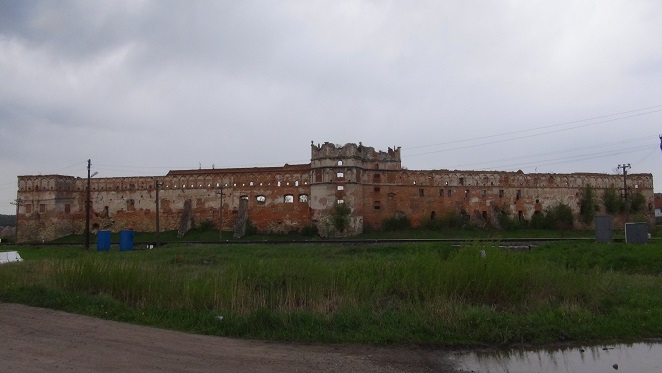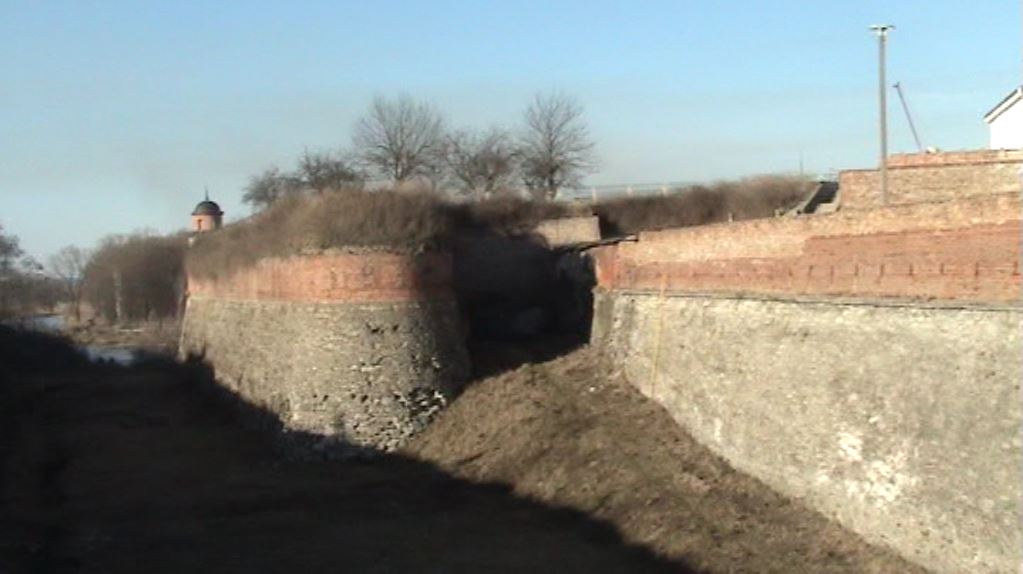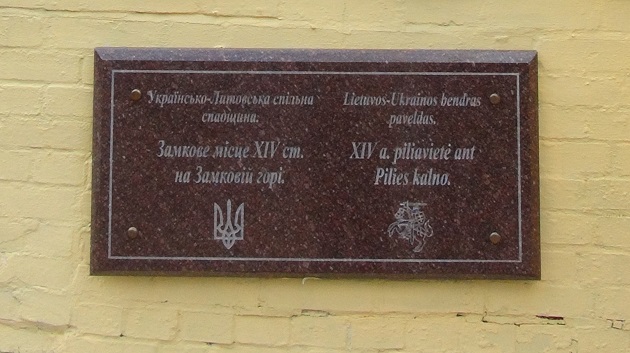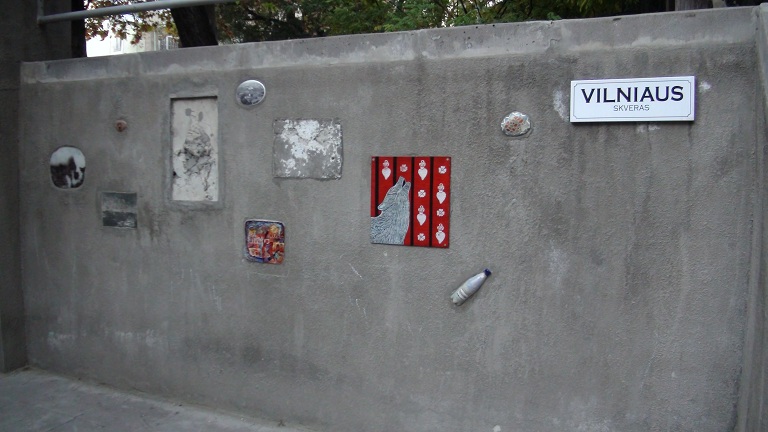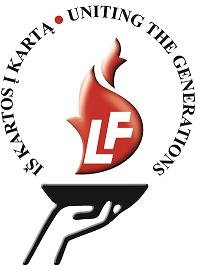Eastern Europe
Note: The part of Europe ruled by communists before 1990 is described here. It includes parts of Asia in the former USSR.
In the 15th-16th centuries, the Grand Duchy of Lithuania was the Europe's largest country. Numerous castles, manors, and their ruins, once established by Lithuanian rulers and noble families, exist in Belarus and Ukraine. The subsequent creation of Polish-Lithuanian Commonwealth (16th-18th centuries) means that many places in Poland and Latvia are related to Lithuania as well. The ethnic boundaries of Lithuanian nation went beyond today's state borders so there are culturally important Lithuanian places in modern-day Kaliningrad Oblast of Russia.

Grand Duchy of Lithuania castle in Kamianets Podilskyi, modern-day Ukraine, used to defend the Grand Duchy from Ottomans, Tatars and Cossacks since it was conquered by Vytautas the Great in 1393 and expanded by his succesors. Elected to be one of the Seven Wonders of Ukraine. ©Augustinas Žemaitis.
The 20th century brought much sadder events. The great Soviet exiles were among the most tragic moments in the Lithuanian history. This was a Soviet policy of 1940-1953 whereby hundreds of thousands of Lithuanians (entire families with children and babies) were stripped of their belongings, stuffed into cattle carriages and deported to various places in Siberia, Kazakhstan and Tajikistan. Many perished - for instance out of those deported in 1941 more than 50% died due to harsh conditions (down to -70 C winter cold) and forced labor in the Soviet concentration camps.
They left only humble crosses now crumbling in permafrost. Since the late 1990s, there have been Lithuanian youth expeditions "Mission: Siberia" to clean these graveyards. Russia is still suspicious of any such activity which reminds the Soviet genocide. Its government impeded the Lithuanian-funded construction of memorials for victims in places like Yakutsk.
The families of the upper and middle class, teachers, artists who refused to glorify Stalin, lawyers, architects, soldiers and anybody deemed "disloyal to the Soviet system" were exiled. The Genocide of Lithuanians was not unique - many other Soviet minorities suffered even worse fate. Many other ethnicities saw their entire population deported (regardless of age, occupation or political views). Such plan was devised for Lithuanians too ("There will be Lithuania - But without the Lithuanians" are the infamous words of Commissioner Mikhail Suslov) but not completed.

Lithuanian deportee graveyard in Irkutsk Oblast, Russia. Tens of thousands of such crumbling crosses exist all over the desolate parts of former USSR and even more graves are unmarked. Photo by expedition Mission: Siberia, aimed at cleaning these graveyards. Epitaph on the left reads: SADDENED WE LEAVE YOU IN SIBERIAN GRAVES, NOT KNOWING WHERE THE WINDS OF FATE WILL BLOW US.
After the death of Stalin, the repressions eased and Lithuanian deportees were allowed to return to the homeland or at least its vicinity. However, the returnees were not given back any property and were always held in suspicion, excluded from decent jobs and education. Therefore some chose not to return and still inhabit the Siberian villages. Such villages are hard to reach and foreigners are still banned from many places there.
While the Soviet expulsions forced more Lithuanians eastwards than anything else there are other Lithuanian marks in the Eastern Europe.
While the Soviet Union effectively banned emigration there was a massive internal migration. Some Lithuanians were given jobs outside their titular country. Today there are Lithuanian communities in the majority of the post-Soviet countries. Soviets established a pan-Union network of Russian language institutions (schools, university programs, theaters, media) at the same time banning minority language institutions, fostering russification. This way the minorities, including Lithuanians outside Lithuanian SSR, had to use Russian institutions and a large share of them adopted Russian language and culture. After 1990 some Lithuanian cultural institutions were allowed to open. They are concentrated to main cities such as Moscow, Kiev or Saint Petersburg.
Belarus
Belarus and Lithuania are neighboring countries joined by united medieval history. Since its inception in the 13th century, the Grand Duchy of Lithuania expanded to Slavic lands absorbing entire modern-day Belarus and ruling it until the Grand Duchy's demise in 1795.
Lithuanian nobility families (with powers higher than those of the King) had manors and palaces both in modern-day Lithuania and Belarus. Belarus also had a fair share of castles that defended the Grand Duchy from Teutonic, Mongol, Rusian and Swedish invasions. The majority of such magnificent buildings are located near the Lithuania's capital city Vilnius. Vilnius is located merely 30 km from Lithuanian-Belarusian boundary meaning that much of Grand Duchy heritage is left "on the other side". Some of these 14th-18th-century buildings are completely rebuilt while others remain as romantic ruins.
Most famous among them are the Mir (Myras) castle and Nesvizh (Nesvyžius) Palace, both rebuilt and recognized as World Heritage by UNESCO.
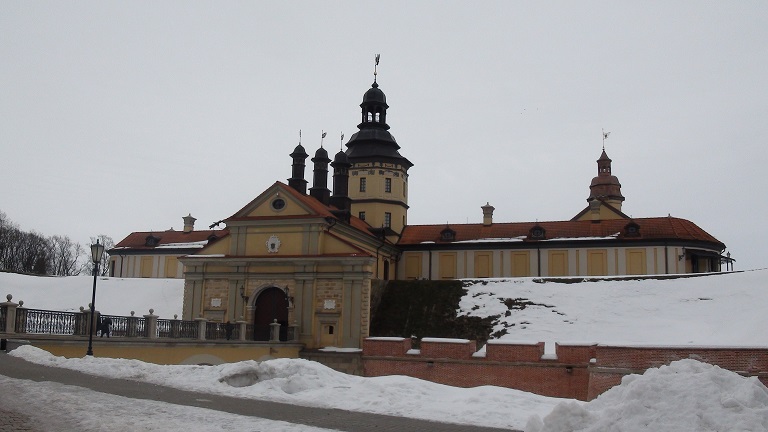

Nesvyžius (Nesvizh) palace from the outside. ©Augustinas Žemaitis.
Ruzhany (Ružanai) Palace and Lida (Lyda) Castle are undergoing renovations. Atmospheric ruins at Golshiany (Alšėnai) still evoke memories of distant past while Kreva (Krėva) and Navahrudak (Naugardukas) defensive castles are ruined more. In Hrodna (Gardinas) two castles have been repurposed by Soviets and even used as workshops.
A multitude of old small Catholic and Orthodox churches and monasteries of the region also dates to the Grand Duchy of Lithuania era. They are Gothic or Baroque (the local form of Baroque is known as Vilnius Baroque and even the Cathedral of Belarusian capital Minsk is an example of this style). Orthodox churches here are similar in style to Catholic ones without the iconic domes.
Prior to the 19th century the areas where most Lithuanian castles and palaces stand had a Lithuanian-speaking peasant majority. However, this did not survive the onslaughts of Russian Imperial and Soviet russification. Currently, only some villages remain Lithuanian. The linguistic switch did not erode some other distinctive cultural traits: the borderland remains Catholic-majority (other Belarusians are largely Orthodox).


Map of Lithuanian castles in Belarus and southeastern Lithuania. ©Augustinas Žemaitis.
Grand Duchy of Lithuania castles and palaces in Belarus
Castles and palaces of Lithuanian Grand Duchy in Belarus are located within 100 km from the modern Lithuanian-Belarusian boundary. They were constructed in the during the golden eras of the Duchy (14th-17th centuries). During 19th-20th centuries (after the Duchy fell) these magnificent buildings were neglected and even scavenged for bricks. After 1991 independence Belarus started rebuilding them (not fully authentically).


Ružanai (Ruzhany) palace undergoing reconstruction. The neglected wing is visible through a restored gate. ©Augustinas Žemaitis.
Grand Duchy of Lithuania is regarded by some Belarusian historians to be the source of Belarusian statehood. There are even interpretations claiming that the Duchy was more Belarusian than Lithuanian. This is however not true as the ruling nobility was mainly of Lithuanian origin, while demography (after the Union of Lublin) was 46% Lithuanian and 40% Belarusian. However, the medieval Lithuania was a very tolerant society for its era. It had been united by largely peaceful means and the 1529 Statute equalized rights of Orthodox Belarusians with those of Catholic Lithuanians.
The first emblem Belarus adopted after its independence was the Lithuanian Vytis (albeit in slightly different colors). Contemporary Belarusian flag (white-red-white) was also based on Vytis (unlike the modern Lithuanian tricolor which is criticized by some heraldry experts for breaking with heraldic tradition). These symbols are still used by opposition alone as after A. Lukashenko came to power in 1995 he switched back to modified Soviet symbols as he associates Belarus more with the Soviet history rather than the medieval one.
Lithuanian castles and manors near Minsk-Brest highway
You may see some of the most magnificent Lithuanian castles along the Minsk-Brest route.
Arguably the most famous among them is Myras (Mir) Castle. Part of UNESCO heritage it was completely rebuilt by ~1995. Initially constructed by Jurgis Iljiničius (George Ilyinich) in late 15th century (gothic style) it was subsequently expanded by the famous Radvila (Radziwill) family (16th century, Rennaisance style). Back then only the richest could have owned a brick castle. A museum is now located inside.


Myras (Mir) castle in the evening. ©Augustinas Žemaitis.
One of the major Radvila family residences is located some 30 km south. This is the fortified Nesvyžius (Nesvizh) Palace commisioned in 1582. Together with Sapiegas, Radvilas were one of the most influential Lithuanian families.
Nesvyžius palace (crowned by a tall tower and joined by a lush park) was a gem of the Radvilas and in turn a gem of the Grand Duchy‘s famous manor culture. Rebuilt in 2010 it houses a modern museum with English inscriptions, computer displays and historical re-enactments (something rare in Belarus). The nearby Nesvyžius town has little authenticity in it as it faced destruction (like most Belarusian towns). However the Radvila-funded world‘s second-oldest Baroque church (after Gesu in Rome) survives while a towered city hall was recently rebuilt.


Opulent courtyard of Nesvizh (Nesvyžius) palace. ©Augustinas Žemaitis.
Naugardukas (Navahrudak) town has a Glastonbury-like atmosphere with Tor replaced by castle ruins on the Mindaugas Hill. Castle has been developed by Grand Duke Vytautas and his successors (14th-16th centuries). The lower town has Grand Duchy churches and even a Tatar mosque signifying the multicultural population of the former Duchy. Stryjkowski chronicle claims that Naugardukas was Grand Duchy’s capital prior to Vilnius but this is unsubstantiated by any other historical documents.


Naugardukas (Navahrudak) castle ruins (left) and one of its old small churches (right). ©Augustinas Žemaitis.
Ružanai (Ruzhany) houses an extensive 18th century Sapiega family palace. The front part that includes gate is rebuilt but the entire horseshoe-shaped arcaded courtyard buildings are ruined. The inspiring former lavishness may still be felt however.


Some of the buildings that surround Ružanai (Ruzhany) palace courtyard. ©Augustinas Žemaitis.
Kosava (some 15 km north of Ružanai) is the birthplace of Tadeusz Kościuszko (Tadas Kosciuška), a Polish-Lithuanian military officer (1746-1817) who reached intercontinental fame as he fought for independence of his homeland, helped USA win freedom and even the tallest Australia’s mountain is named after him. A restored wooden hut marks his birthplace. From this hut one may see a Turkish-inspired palace of Wandalin Puslowski nearby (ruined, under restoration) but it dates to the post-Lithuanian era (1831).
Lithuanian castles and manors near the Lithuanian border
South of modern day Lithuania there are two large cities of Hrodna (Gardinas; pop. 300 000) and Lida (Lyda; pop. 100 000). Lida was part of Lithuanian-inhabitted core of the Duchy while Hrodna marked its limits. Both cities were defended by might castles.
Rectangular Lyda (Lida) Castle (built by Grand Duke Gediminas in the 14th century) defended by two towers was built in plains rather than on a hill. Now rebuilt its courtyard houses various events. In medieval eras it housed expelled khans of the Mongol Golden Horde.


Gediminas Castle in Lida. ©Augustinas Žemaitis.
Hrodna (Gardinas) has two castles, both located next to each other on twin hils at banks of river Nemunas. The Old Castle has been constructed by Grand Duke Vytautas the Great whereas the palace-like New Castle dates to 17th century. Their interiors were destroyed by Soviets (Old Castle now houses wood worksops). Between the castles a Lithuanian-funded wooden sculpture of Vytautas is located, one of merely few statues for Grand Duchy-era luminaries in Belarus.


The Old Castle of Hrodna and Vytautas the Great statue. ©Augustinas Žemaitis.
Merely some 50 km east of Vilnius, just beyond Medininkai border control point there are remains of two once-glorious castles: Alšėnai (Golshiany) and Krėva (Kreva). Alšėnai was yet another residence of the Sapiegas. The remaining ruined part is not completely destroyed as you may still see former internal walls and filled cellars (and imagine the magnificient past).


The remains of Alšėnai Castle. ©Augustinas Žemaitis.
Few Lithuanian castles could outdo Krėva (Kreva) in historical importance. It was the location of 1385 Union of Krewo that made Lithuanian Jogaila also a Polish king (known there as Jagiello) and tied the histories of both nations for upcoming five centuries. Additionally it is likely that Grand Duke Kęstutis had been previously murdered in Krėva by Jogaila’s conspirators. Currently however Krėva is ruined. The rectangular walls are destroyed in places and only the lower part of rectangular towers remain intact.
A map of Lithuanian castles and palaces in Belarus is available here
Lithuanian-majority areas of Belarus
Prior to the 19th century, the entire castle-rich Belarusian-Lithuanian frontier was inhabited by an ethnic Lithuanian majority. Historically the Lithuanian nation was dominant in a far larger territory than the modern-day Republic of Lithuania. This is still visible in placenames: a lot of them in northwestern Belarus are of Lithuanian origin (the endings are Slavicised: Trakeli, Lazdūny, Kiemeliški, Gulbiny, Kiškeliški...). The letters "išk" ("ishk", "iszk") are unique to Lithuanian-origin placenames.
Lithuanians of the region assimilated into Slavic communities during the Russian Imperial and Soviet onslaughts of russification. Russian Empire banned the Lithuanian language in the mid-19th century and while the people of western Lithuania found it easier to illegally import Lithuanian books from Germany this was not the case in modern-day Belarus. The percentage of Lithuanian native speakers in Vilnius governorate (which included much of modern-day Belarus) decreased from 35%-40% in the mid-19th century to 17%-20% in ~1914. After a short Lithuanian rule, the region was captured by Poles in 1920 and the ongoing Polish-Lithuanian conflict over Vilnius led to further discrimination of the minority. The final blow was, however, the Soviet policies. Many Lithuanian majority areas were added to Soviet Belarus instead of Soviet Lithuania, all Lithuanian schools were then closed and even public speaking in Lithuanian prosecuted. In this era many Lithuanians left for Lithuania, others adopted the Russian language.
Several territories still contain Lithuanian communities. The largest of them is around Gerviaty (Gervėčiai) village (~14 villages, 9 of them Lithuanian-majority). Some 1000 Lithuanians live there today. A Lithuanian cultural center and Lithuania-funded Lithuanian school (Rimdžiūnai village) are at the heart of the community. While the older generations associate themselves with Lithuania, the kids rarely speak Lithuanian natively. The choice of whether to send them to Lithuanian or Belarusian school typically depends on the future their parents expect for them. The Lithuanian school even has some Belarusian students who are being prepared by their families for emigration to richer Lithuania. In Mykoliškės (Michailiški) village near Gerviaty (Gervėčiai) a new Astravec Nuclear Power Plant has been built. Its workers are brought in by Russia and some Lithuanian-owned homes were demolished to make a place for new constructions.
The most impressive building in Gervėčiai area is the gothic revival Gervėčiai church (1903). Lithuanian in style and massive size (62 m tall tower) it outflanks the 600-strong village. In fact, it is the largest Catholic church in Belarus and is still adorned by Lithuanian inscriptions and surrounded by tall elaborate Lithuanian wooden crosses (Lithuanian art of crossmaking is an immaterial UNESCO World Heritage).
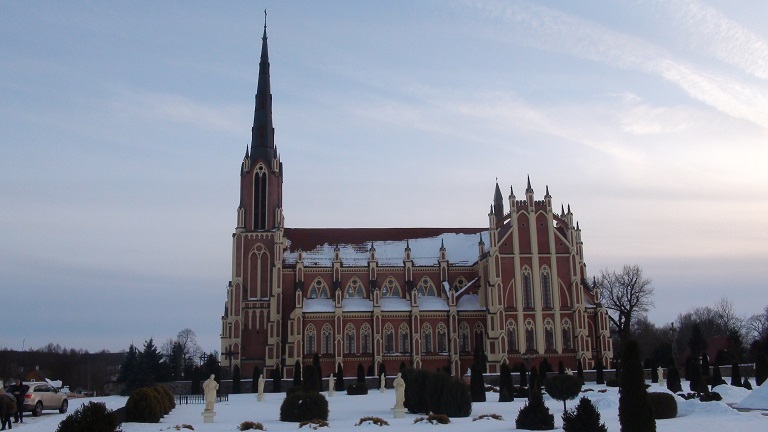

The massive Gervėčiai church. ©Augustinas Žemaitis.
Other Lithuanian majority areas that survived until the Soviet occupation (1939) now are decimated. These are the villages around Varanavas, Pelesa, Apsas, Lazdūnai.
Pelesa still hosts a Lithuanian-language school funded by the Lithuanian government. In 2010, a wooden sculpture for Lithuanian Grand Duke Vytautas the Great was erected near the Catholic church of Pelesa (sculptor Algimantas Sakalauskas).
Even those regions where the Lithuanian language is no longer spoken at all still are distinctive from the rest of Belarus. The Catholic religion dominates there instead of Russian Orthodoxy, some Lithuanian traditions also survive.


Lithuanian crosses near the Gervėčiai church. ©Augustinas Žemaitis.
In addition to the centuries-old aforementioned communities, the 19th century Russian Imperial occupation led to the creation of new Lithuanian communities even in the eastern Belarus. With no limits on internal migration, some Lithuanian peasants left for eastern Belarus to establish Lithuanian villages such as Malkava (now Malkovka). Unfortunately, the Soviet deportations and russification totally uprooted these communities.
Poland
Poland has much Lithuanian heritage as Lithuanian and Polish destinies have been intertwinned for centuries. Between 1569 and 1795 Poland-Lithuania was a united Commonwealth and many Lithuanian decisions used to be taken in modern-day Poland. Cracow served as the joint capital and its Wawel castle is a pantheon of Lithuanian monarchs as well as Polish.
Poland still has locations where ethnic Lithuanians are a majority (Punsk/Punskas, Sejny/Seinai area). Those are likely the only foreign places where one can feel as in Lithuania. There are Lithuanian museums, inscriptions, Christian masses and schools. Patriotism likely surpasses that in Lithuania; Columns of Gediminas are used extensively in building decor.
Armies from nations further West have passed or used to base themsleves in Poland when marching against Lithuanians. Northern Poland (Malbork castle) used to serve as a base for Teutonic Knights and the Grunewald (Žalgiris) battle has been fought not that far away. The famous pilots Darius and Girėnas died there as they flew towards Lithuania after crossing the Atlantic ocean (memorial now stands).
Cracow: The heartland of Polish-Lithuanian commonwealth
Between 1569-1795 Lithuania and Poland were a single country - Polish-Lithuanian commonwealth. The collabortive efforts started much earlier by 1385 Union of Krėva (Krewo) when Jogaila (a Lithuanian) was crowned as king of Poland. Jogaila was a scion of Gediminid dynasty (ruling Lithuania at the time), but as he was the first Gediminid to rule Poland the Poles call the dynasty Jagiellonian after him. Gediminids/Jagiellonians then vied with Habsburgs for prevailing in Eastern Europe. Many dynasty kings are buried in Cracow which was the Polish-Lithuanian capital.
Main pantheon of Cracow is the Wawel Cathedral, part of the royal palace. Jogaila himself rests in a covered red marble grave. Most other leaders are buried in the cellars. Holy Cross chapel has a grave of king Casimir (1440-1491), Sigismunds (Žygimantai) chapel includes graves of Sigismund the Old (1506-1548; Lithuanian: Žygimantas Senasis) and Sigismund Augustus (1548-1572; Lithuanian: Žygimantas Augustas). Maryacka chapel is the final resting place of Stephen Bathory. Vasa chapel has been constructed for the Vasa dynasty of Swedish origin which was elected to rule Poland-Lithuania by its nobles after the Gediminids died out. There are also graves of Jan Sobieski (Lithuanian: Jonas Sobieskis), Michael Karibut Wiszniowecki (Lithuanian: Mykolas Kaributas Vyšnioveckis), Stanislaw Leszczynski (Lithuanian: Stanislovas Leščinskis) and August the Saxonian (Augustas Saksas). Adam Mickiewicz (Adomas Mickevičius) - A poet who wrote in Polish but considered himself Lithuanian because of his Lithuanian origins (something not unusual in the era) - is also buried there, as is the leader of 1794 uprising Tadeusz Kosciuszko (Tadas Kosciuška).


Medieval sites of Cracow. Wawel hill, its palace and cathedral are depicted on the bottom images and top left. Top right/center images show the remaining medieval district, once the capital of both Poland and Lithuania. ©Augustinas Žemaitis.
The Wawel grave of Poland-Lithuania's final king Stanislaw August Poniatowski is however empty. After Russia annexed Lithuania and much of Poland by 1795 he lived in exile in Saint Petersburg and was initially buried there. In 1930 the Soviets offered Poles to return the remains but the Polish opinion on "the king under whose rule the country collapsed" was understandably divided. He was thus reinterred in a village near Brest (today's Belarus) rather than Wawel in 1938 and moved to Warsaw's St. John Cathedral after the Poland's communist regime went bust.
Cracow University is named after Jogaila (Jagiello).
Warsaw: The capital of Poland-Lithuania
Warsaw became the capital of Polish-Lithuanian Commonwealth in 1596. It was transferred there by king Zigmantas Vaza (Zygmunt Vasa) from Cracow. The place had been chosen as a mid-point between Cracow and Vilnius, respective capitals of Poland and Lithuania (in reality Warsaw is 450 km from Vilnius and 300 km from Cracow, this likely representing the larger Polish influence in the Polish-Lithuanian Commonwealth).
Polish-Lithuanian Commonwealth existed for two more centuries, allowing Warsaw to accumulate locations that remind of the Polish union with Lithuania.
Likely the most important among them is the Royal Palace (destroyed during WW2, rebuilt afterwards) which once housed the family of the monarch of "both nations". Polish-Lithuanian monarchs had little influence at the time and the real Power was vested in Seimas (Parliament), which also convened in the same palace (Great Hall). The world's second constitution (1791 05 03) was proclaimed there. Near the Great Hall ceiling there are coats of arms of Poland and Lithuania (Vytis) as well as the coat of arms of all the Voivodships (administrative units), of which three (Samogitia, Vilnius and Trakai) were within the area of modern-day Lithuania. They are represented by the Samogitian bear, Vilnius Voivodship symbols (which includes Vytis), and a plain Vytis representing Trakai (as the Voivodship had no coat of arms, using the Lithuanian one instead). The Palace museum has many historic maps of Lithuania.


Royal Palace of Warsaw. ©Augustinas Žemaitis.
In Warsaw St. John's Cathedral the final joint ruler of Poland and Lithuania King Stanislaw August Poniatowski (Lithuanian: Stanislovas Augustas Poniatovskis) is buried. There are also commemorative plaques for Vilnius University and Poles of Lithuania. Moreover, the Cathedral is also the final resting place of Gabriel Narutowicz (Lithuanian: Gabrielius Narutavičius) who was born in Telšiai to a family of somewhat Polonized Lithuanian nobility. They reflected the final division of a "Polish-Lithuanian nation" as Gabriel Narutowicz's own brother Stanislovas Narutavičius became one of twenty signatories of Lithuanian declaration of independence on 1918 02 16. The Polish-Lithuanian relations reached their nadir soon afterwards with the Polish occupation of Vilnius region when entire Eastern Lithuania became ruled from Warsaw once again (1920-1939). References to the era in Warsaw plaques may still evoke controversy among Lithuanians.
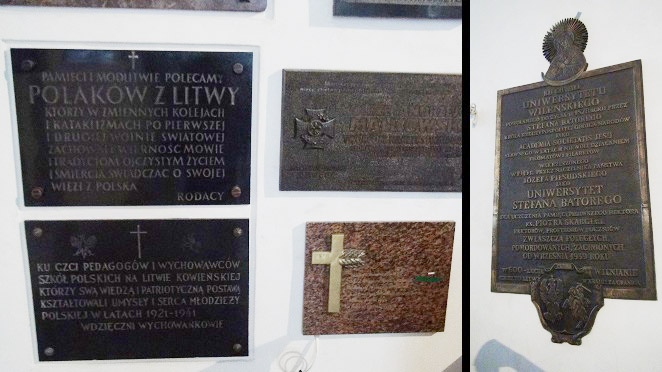

Plaques for the Poles of Lithuania (left), Vilnius University (right). ©Augustinas Žemaitis.
Warsaw street names remind of other Polish-Lithuanian era figures. The only difference from similar memorials you may find for them in Lithuania are in names: Poles use Polish versions while Lithuanians use Lithuanian ones. For example, Emilii Plater in Warsaw is the same famous female fighter against Russian domination that is known as Emilija Pliaterytė in Lithuania.
Northern Poland: Former Germany’s East
Before World War 2 most of today's northern Poland was ethnically and politically German.
During the 13th-15th centuries, pagan Lithuania fought a seemingly eternal war against the German Teutonic Knights who sought to spread Christianity (according to critics, more likely to loot and destroy). Their headquarters was Malbork (Marienburg) castle, today rebuilt for better imagination of knights' lifestyle.
The largest of the battles against the crusading knights took place in Grunewald (known as Tannenberg in Germany, Žalgiris in Lithuania). ~70 000 soldiers participated in this one of the largest medieval battles where a united Lithuanian and Polish force vanquished the Teutonic Knights. The battlefield is now a popular tourist place with medieval souvenirs and a megalomanic monument. The battle has great importance in Lithuania as many streets and sports franchises are named after it, including the most powerful basketball (Žalgiris Kaunas) and football (Žalgiris Vilnius) teams.
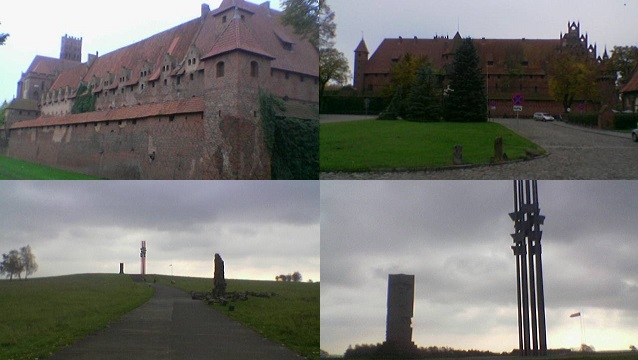

Sites reminiscent of the crusading Teutonic Knights: formidable red-brick Malbork castle (top) and an atmospheric Žalgiris battlefield with its monuments, the metal-poles one covered with coats of arms of all the regions that amassed anti-crusader armies in that battle (bottom). ©Augustinas Žemaitis.
In Soldin forest near Myslibisz, a plane "Lituanica" crashed in 1933. Piloted by Steponas Darius and Stasys Girėnas this plane flew succesfully over the Atlantic with destination in Kaunas only several hundred kilometers away. It was the second longest flight time today, first Lithuanian plane to cross the Atlantic and the world's first transatlantic airmail service (the mail did not burn and was symbolically flown from the crash site to Lithuania the next day). The pilots became martyrs and even the Nazi Germany permitted construction of the Lithuanian pilots monument (two interlinked crosses) at the crash site in 1936 despite the German claim over Klaipėda region which shattered Lithuanian hopes to participate in Berlin Olympic games the same year. The monument has original German and Lithuanian plaques. After World War 2 when the lands were added to communist Poland a Polish plaque was installed. Curiously the monument survived even the iconoclastic communist regime and remained a place of respect. A traditional Lithuanian chapel-post now stands at the place where Steponas Darius body was discovered; a memorial barn is nearby.
The Gdansk-Sopot-Gdynia tri-city is now famous for its three supermuseums, very large and modern. Each of them is at least somewhat related to Lithuania. European Solidarity Center tells the story of the Solidarity movement that eventually deposed Polish communism. However, it also covers the entire life under the communist system, as well as the collapse of communism. Each ex-communist-ruled nation, including Lithuania, is dedicated a stand.
Second World War museum (Gdansk) also covers the events that influenced Lithuania. The museum is controversial, though: its original creators were from outside Central/Eastern Europe and their knowledge of local history proved to be superficial. Some exhibits were partly based on Soviet propaganda. Seeing this, the Polish government initially refused to open the museum but later opened it after rectifying the anti-Polish exhibits. Sadly, although anti-Polish claims were removed, anti-Lithuanian claims, as well as Soviet-propaganda based claims or spins about many other nations of the region, have remained. So, for instance, the very first quote about Lithuanian freedom fighters is that "Some of them were Nazi collaborators", etc.
The third supermuseum is Museum of Emigration in Gdynia. While it specifically deals with Poland's emigration, since ~1860 Poles and Lithuanians basically emigrated to the same destinations (even to the same cities and towns of the USA), so much of what is presented is also applicable to Lithuanians. Furthermore, some of the 19th-century Polish diaspora figures are considered to have been Lithuanian diaspora figures by Lithuanians: that is because Poland-Lithuania was a united country until 19th century and there were many people of Lithuanian origins who spoke Polish due to linguistic shift; these are now often considered to have been Poles by Poland and Lithuanians by Lithuania.
East of Gdansk one may visit Stutthof Nazi concentration camp, now a museum. It is rare among the concentration camps in that Jews did not make the majority of prisoners here. Instead, the camp was used to imprison many ethnic Lithuanians, Latvians, and Estonians who were seen as anti-Nazi, including leftist writer Balys Sruoga and politician Jonas Noreika. Balys Sruoga wrote a black-humour-filled book "Dievų miškas" (Forest of Gods) about the camp, which is seen as a Lithuanian literary classic due to its uniqueness in still being able to look at the world in a somewhat non-serious way despite the great suffering. Inside the concentration camp one may still feel the horrible atmosphere they suffered.
Sejny/Seinai and Punsk(as) area: Lithuania inside Poland
The Northeasternmost area of Poland is unique in the world. This is the only area beyond the Lithuanian boundaries where Lithuanians make the majority (~80%). Lituanity is felt here even better than in Lithuania itself: home fences and even a derelict former gas station bear patriotic symbols such as the towers of Gediminas. Many signs are bilingual Polish and Lithuanian. Unlike in Lithuania, in Poland bilingual signs are permitted in minority-majority areas. There has been situations however when vandals damaged the Lithuanian part of the signs but ~2013 most have been rebuilt.
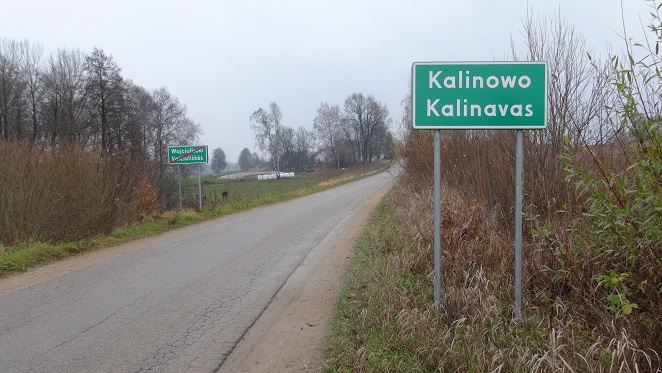

Bilingual Polish/Lithuanian signs in the Lithuanian-majority area of Poland. These are the only official Lithuanian signs outside Lithuania. ©Augustinas Žemaitis.
The capital of Poland's Lithuania is Punsk (Punskas, pop. 1200). Its Accension church yard hosts a monument to Lithuanian anti-Soviet partisans. The daily mass is celebrated in Lithuanian and only in Sundays there is a single Polish mass. Church interior is more Polish however, with gold-plaqued statues of saints. Lithuanian museum is nearby. There are two of them in Punsk: Juozas Vaina ethnographic museum and Punsk history museum. Punsk also hosts March 11th complex of Lithuanian schools. Near the complex, a traditional Lithuanian wooden monument was built in 2000 to commemorate 400 years anniversary of schooling in Punsk. The monument is 5,1 m tall and its author is Algimantas Sakalauskas, while Romas Karpavičius constructed the metal cross on the top.
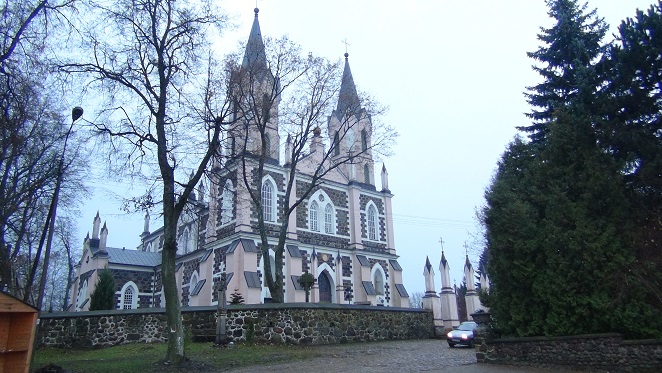

Church of Punskas next to the main square. ©Augustinas Žemaitis.
The greatest modern gem of Punskas area is the Prussian-Yotvingian settlement in Ožkiniai village (2 km south of Punsk). Prussians and Yotvingians were Baltic tribes (related to Lithuanians) annihilated by German crusaders; they remained pagan and left few historical descriptions. Nonetheless, a local Lithuanian businessman enthusiastically builds up the massive locality since 2001. No one can tell if it looks authentic or not but it certainly feels atmospheric and believable, with a small castle surrounded by a ditch, a village, places for sacred fires, Baltic heroes path of fame. The settlement is well integrated with the local forest and no modern edifices are visible from no locations. One can feel as in the past; both Poles and Lithuanians bring their excursions here and Baltic neo-pagans celebrate their holidays.


A small wooden castle surrounded by a ditch in the Prussian-Yotvingian complex. ©Augustinas Žemaitis.
A more traditional open-air museum (skansen) is located going from Punsk towards Sejny. It includes a 19th century 5-building farmstead full of museum materials, there is a barn and an inn, and all these are outflanked by a modest Žalgiris battle monument. Recent extensions include two "tents of masters" (one for a language master and another one for music master) and an improvised ground labyrinth that leads to a written folktale of "Eglė the Queen of Serpents" (in Lithuanian, Polish and Belarusian), an observation point, and some activities. An annual amateur village theater festival takes place here.


The inn of Lithuanian skansen in Punsk. The stone in front is dedicated to Lithuanian theater. ©Augustinas Žemaitis.
Minor places of interest around Punsk are a stone commemorating 1990 Lithuanian independence restoration (in Kampuočiai), a memorial for knygnešys P. Matulevičius (1956, in Kreivėnai), Vytautas the Great memorial (1930, Burbiškiai). There are many stone crosses with Lithuanian inscriptions.


Another part of the Prussian-Yotvingian farmstead. Symbols are abound: some well known, others mysterious. ©Augustinas Žemaitis.
The largest town in the area is Sejny (Seinai, pop. 6000). It is an old diocesan centre, anchored on the 1632 Virgin Mary church. The castle-like former priest seminary and monastery stands nearby. Sejny was once a Lithuanian town and the early 19th century creators of the seminary claimed that people in Sejny area "speaks little Polish". During the Lithuanian National Revival Sejny has been an important center of Lituanity where a Lithuanian "Šaltinis" newspaper used to published since 1906. In 1897 a Lithuanian writer Antanas Baranauskas became Sejny bishop (his sculpture has been constructed in 1999 in front of the church under Lithuanian efforts; he is buried under the church). Author of the Lithuanian National Anthem Vincas Kudirka as well as Vincas Mykolaitis-Putinas who later wrote a semi-autobiographical book on priest's celibacy/love dilemma, both studied at the seminary. Out of the 25 students in 1829, 21 were ethnic Lithuanians.
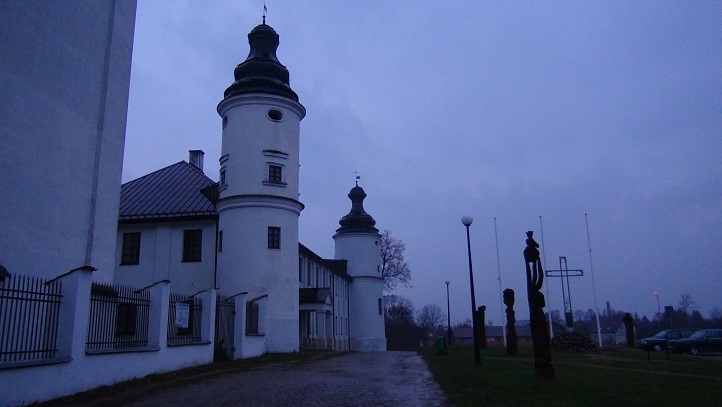

The seminary of Sejny prepared many famous Lithuanian priests. Today building is used as a museum. ©Augustinas Žemaitis.
The final fate of Seinai (and Punskas) has been decided in years 1919-1920. Both Lithuania and Poland were newly independent and were partitioning the lands of the former Commonwealth. The power in Seinai/Sejny switched many times these years, but the 1920 capture of the town by Polish forces proved to be final (the Poles continued their advance on Vilnius and Eastern Lithuania, and the bitter Polish-Lithuanian territorial dispute continued until World War 2). Berzniki village cemetery is full of the reminiscences of those days. Lithuania has recently built a gravestone with the inscription "To those died for motherland freedom" there for its fallen soldiers of the 1920 battle. Some Poles protested the inscription claiming that these soldiers died when attacking Poland. One opponent was a local priest who initiated construction of a neighboring "Ponary cross" for "Polish civilians killed by Lithuanians in World War 2" (even though the Berzniki cemetery has no graves of such victims). On the other side of the Lithuanian memorial, a stone with a list of Polish-conquered cities in 1920 now stands (among them the Lithuanian town of Druskininkai). Furthermore, an "alternative" memorial for Lithuanian soldiers was built by the Polish side - a cross beyond the cemetery wall where an inscription declares that Lithuanians helped the Russians to attack Poland. All these events created a diplomatic friction and even caused Poland's Lithuanians to appeal to a Vatican nuncio claiming the priest's actions are against Christian spirit.


Soldier graves with Lithuanian-tricolor ribbons in Berzniki cemetery. ©Augustinas Žemaitis.
The true events of the era were such: "Lithuanian" and "Pole" were a political choice rather than just ethnic categories: many people of Eastern Lithuania spoke Polish better than Lithuanian even though they were of Lithuanian origins (due to a centuries-long linguistic shift). Lithuania considered them to be Lithuanians, Poland considered them Poles (and sometimes even held the entire Lithuanian nation to be a subset of Polish nation). A war started and its results still cause some Poles and Lithuanians to dislike the other nation. This hate came through during the World War 2 when there were both Poles who murdered Lithuanian civilians and Lithuanians who murdered Polish civilians (the Berzniki cross however remembers only the latter). The Polish-Lithuanian war partly overlapped with the Polish-Russian war, that's why Lithuanians are accused of helping Russians (even though Lithuanians and Russians had a different agenda and even fought each other in the same volatile 1918-1922 period).
Currently, Sejny is ~17% Lithuanian and there are few Lithuanian inscriptions but the town is still a center of Lithuanian culture. Lithuanian mass is celebrated in the church, a Lithuanian consulate is nearby, there is a Lithuanian "Žiburys" school (2005), a cultural center "Lithuanian home" (1999), bi-weekly newspaper "Aušra".


Antanas Baranauskas sculpture in Seinai/Sejny. At his foot are green Columns of Gediminas a Lithuanian patriotic symbol popular in the region. ©Augustinas Žemaitis.
Punsk and Sejny area forms just a small part of Podlaskie (Lithuanian: Palenkė) Voivodship. This territory of 1 200 000 inhabittants with a captal in Bialystok (Lithuanian: Balstogė) was part of the Lithuanian Grand Duchy until the Polish-Lithuanian Union of Lublin (1569). The name "Palenkė" means "[A Lithuanian land] next to Poland". The modern voivodship has been established in 1999 but its coat of arms reminds its history: it is a combination of the Polish eagle and Lithuanian vytis. Vytis is also used in the coats of arms of Bialystok, Bransk, Sedica and other cities/towns; many cities/towns of the area has historical Lithuanian names that are not a simple transliteration of the Polish ones.
Large cities of Russia: Moscow, Saint Petersburg, etc.
The main Russian cities have a multitude of locations related to Lithuania and its history, many of them dating to the Soviet and Russian Imperial eras when Russia ruled Lithuania.
Moscow and Saint Petersburg - two Russian capitals - still have reminders that for 170 years Lithuania was ruled from there: buildings, museum exhibits, street names and historical places.
Soviet era Lithuanian heritage in Russian cities
The Soviet genocide of Lithuanians (1940-1953) and related mass expulsions to Siberia are the most infamous Soviet action in Lithuania. However, after 1953 many Lithuanians were relocated to major Russian cities willingly or semi-willingly.
Moscow and Saint Petersburg were considered to be prestigious places to live at the time as there had been less shortages, better healthcare and education, more impressive architecture, etc. Only a minority of those wishing so were allowed to live there and this included some Lithuanians, a significant part of them collaborators with the Soviet regime.
Tens of thousands other Lithuanians were moved as simple workers to the smaller Russian cities. Unlike the victims of the 1940-1953 expulsions the people transfered later were given a place to live and had to work in similar conditions to other local workers rather than as slaves.
The new Lithuanian communities however largely remained anonymous and intermingled with others: any promotion of non-Russian culture outside the "titular homeland" (Lithuanian Soviet Socialist Republic in case of ethnic Lithuanians) was heavily discouraged. Lithuanians were expected to become part of the Russophone whole as they used Russian schools, theaters and media without a possibility to converse in Lithuanian outside of the immediate family. Buildings constructed by Lithuanians thus could not be distinguished from those built by the other ethnicities in the same cities, no Lithuanian memorials were allowed to be built. This is in striking contrast to Russians in Lithuania who had their schools, memorials and cultural institutions even in cities where they were a small minority.
Lithuanian embassy in Moscow (Borisoglebskiy pereulok) also dates to the era and its somewhat historic. It has been built as a representative office of the Lithuanian Soviet Socialist Republic. Every Soviet Socialist Republic used to have such an office before 1991. Lithuanian communists and factory representatives would live there when visting Moscow for political purposes. Therefore, atypically for an embassy, it still owns a large multistorey hotel.


Facade of the Lithuanian embassy in Moscow (left). Google Street View.
Lithuanian SSR also owned a pavillion in the All-Union Agricultural Exhibition (subway station "Vystavochnyj Centr"). This exhibition has been opened in 1935 but as Lithuania was still independent at the time (occupied in 1940) the Lithuanian pavillion has been constructed in 1954 when the exhibition had been reopened after World War 2. Every Soviet-ruled country presented its agriculture and industry in this exhibition. Lithuanian pavillions (like most others) is built in then-mandatory Stalinist (a.k.a. Socialist Realist or Soviet Historicist) style that mixed grandeur with historic details. However the building has been designed by Lithuanian achitects (A. Kumpis, J. Lukošaitis, K. Šešelgis), therefore unlike the "internationalized" buildings elsewhere it had national elements. Tricolors and other Lithuanian patriotic symbols had been banned thus the architects expressed Lithuanian heritage through folk patterns and Baroque forms (at the time Baroque was held to be the most Lithuanian among the Western styles due to its prevalence in Vilnius Old Town). The Exhibition has been closed in 1964, leaving Lithuanian pavillion to be used as a chemistry museum (the communist sculpture that crowned the top has been removed however).


Lithuanian pavillion while the exhibition was still open. Original image.
The exhibition area aso has a fountain dedicated to the "Friendship of Nations" (whcih supposedly existed in Stalinist Soviet Union). In this fountain every one of the 16 major nations which had their own Soviet republics is represented by a single sculpture (Lithuania is represented by a girl).
In order to present Lithuania as a part of the socialist eastern world many streets and other locations in the new micro-districts of Soviet cities have been named after Lithuania (Litovskiy, Litovskaya). These names largely remain.
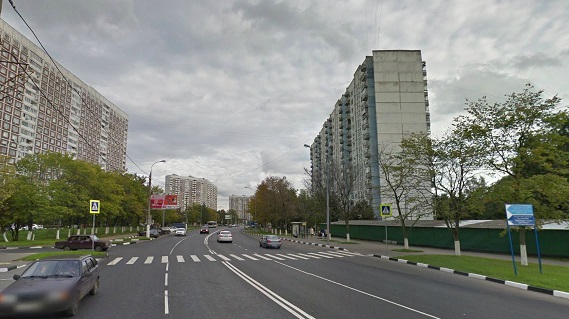

Lithuanian street in Moscow. Like in nearly every late-Soviet district most buildings here look similar to the resdientials in any other Soviet city. There are no Lithuanian elements save for name. Google Street View.
Lithuanians themselves however used whatever means they had to show the world that Lithuania is ilegally occupied. For example, Stanislovas Žemaitis self-immolated in Moscow's Revolution square (Ploshchad' Revolyutsii) in 1990 protesting the Russian blockade of Lithuania. However this and other places of pro-Lithuanian protests remain unmarked. One exception is the painting "Danaë" by Rembrandt in the Saint Petersburg State Hermitage museum. The painting has been heavily damaged by a Lithuanian Bronius Maigys who attacked it with acid and knife in 1985. He targetted the Hermitage as a symbol of Russian state power. The now-restored painting has a comment about the attack underneath - however, it claims the attacker to have been "a maniac" (as the people who disagreed with the Soviet regime used to be called at the time).
Lithuanian heritage in Czar-era museums and culture
The major Russian museums also have some pretty things associated with Lithuania - however Lithuania is usualy represented as a part of Russia. This is because such museums were established before 1915 when Lithuania was ruled by Russian Empire. The Russian Ethnography Museum in St. Petersburg (4/1, Inzhenernaya Ulitsa) has Lithuanian ethnic materials (folk costumes, etc.) next to similar materials of other ethnic groups of the former Russian Empire. Russian Museum (est. 1898, 17 Nevsky Prospekt) of Fine Arts hosts works by Mikalojus Konstantinas Čiurlionis, the most famous Lithuanian painter.
Back in that era the Czar's regime decided to keep Lithuania an agricultural hinterland. Therefore Lithuanians had to seek education and careers jobs abroad. Many Lithuanian scholars, artists and scientists chose Saint Petersburg, the capital of what was then the Russian Empire. Even the final prerevolutionary Catholic bishop of Saint Petersburg was an ethnic Lithuanian (Teofilius Matulionis). To this day Saint Petersburg University of Philology has a Baltic languages faculty. After 1918 most Lithuanians returned to build newly indpendent Lithuania however.
1897 Russian census ennumerated 300 000 migrants from Lithuania in Russia. However, most of them were ethnic Jews. Unlike largely peasant Lithuanians, most Jews were craftsmen and businessmen and felt little attachment to the land. Lithuanian and Russian cultures were equally foreign to them and the Russian cities offered more economic opportunities. After migrating there most Lithuania's Jews swiftly assimilated into the Russian Jewry without keeping any ties with Lithuania.
Knowing the recent history it may be hard to believe that once the Russian state was smaller than (the Grand Duchy of) Lithuania. Kazan Cathedral on the corner of the Red Square has been built in 1625 (demolished 1936, rebuilt 1992) to mark the forced departure of Poland-Lithuania forces that had previously taken Moscow in support of a throne-claimant Dmitriy. This happened in 1612 and was one of the very few times in history that Moscow was entered by foreign troops. In 1818 a statue for Kuzma Minin and Dmitriy Pozharski who led the fight against Poland-Lithuania was erected in the Red Square, it is now located in front of St. Basil's Cathedral and remains the sole sculpture in the Red Square.
Modern Lithuania-related places in Russian cities
The collapse of the Soviet Union ended Lithuanian migration to Russia, however the Lithuanians who lived there were finally able to practice their culture more freely, even if without the government support.
Myakinino suburb of Moscow has a Lithuanian cuisine restaurant "Gedimino dvaras" ("Gediminas's Manor") at 4-Myakininskaya 27A, near Strogino and Myakinino metro station. It has been opened in 2011 by two Russians Veronika and Igor Bezuglovs, who met each other in a local reality TV show.


Lithuanian restaurant Gedimino Dvaras in Moscow. Google Street View.
Since 1992 a Lithuanian Jurgis Baltrušaitis school works at Gospitalnij per. 3 in Moscow. Unlike the Russian minority schools in Lithuania however the Moscow's Lithuanian school does not use the minority language for instruction. All lessons are in Russian, however Lithuanian language is taught as an additional subject (these lessons funded by the Lithuanian sgovernment). The building has been built in 2005 but there are no Lithuanian architectural details. Jurgis Baltrušaitis was a long time Lithuanian ambassador to Russia in the interwar period.
Today Moscow has ~2000 Lithuanians. Saint Petersburg has ~3500 Lithuanians, a Lithuanian house (actually an apartment) and Lithuanian Catholic mass in the Seminary church (Krasnoarmeiskaja 11). Lithuanian communities also exist in Murmansk, Smolensk, Vladivostok, Samara, Omsk, Tomsk, Medvezhegorsk.
Latvia
Latvia and Lithuania are known as "brother nations". Not only they are neighbors which never fought a war but their languages are the final remaining examples of once mighty Baltic language group. 30 000 Lithuanians live in Latvia today, comprising 1,5% of total population.
Lithuanian-Latvian ethnic boundary have always been a fluid one with many frontier villages and towns ethnically mixed. The current oficial boundary was established by arbitration in 1922, after both Lithuania and Latvia became independent from Russian Empire. Some heavily Lithuanian towns and villages were left on the Latvian side, including Aknīste (Lithuanian: Aknysta), Ilūkste (Lithuanian: Alūkšta). These border areas still have sizeable Lithuanian communities.
Lithuanians shared Latvian cities
Latvia also became a refuge for Lithuanians at times when occupational govenments persecuted them. In 1795-1915 both Lithuania and Latvia were occupied by the Russian Empire. Lithuanians however felt a bigger wrath of the Czar with Lithuanian language banned and a decision made to leave Lithuania an agricultural hinterland.
Latvia, on the other hand, had its cities and industry developed (and faced no language bans). Riga had over 500 000 inhabittants in 1914, almost the same number as it does today (650 000), and was 3rd-5th largest city of the Russian Empire. 35 000 of them were ethnic Lithuanians mainly seizing the oppurtunity to work in factories. With their homeland still agricultural this meant that there were more Lithuanians in Riga than in any city or town of Lithuania itself.
Total number of Lithuanians in Latvia was 100 000 in 1914. Many lived in the cities closer to the border: Daugavpils (Daugpilis), Jelgava, Liepāja (Liepoja). In Liepāja 25% of population (17 500 people) were Lithuanians and the city's gymnasium became the alma mater of the future Lithuanian elite. Among its students were two of the three interwar presidents of Lithuania (A. Smetona and A. Stulginskis), several ministers, writers and politicians. Today its building houses Liepāja University (Krišjāņa Valdemāra iela 4).


Former Liepaja Gymnasium. For now it lacks commemorative plaques for famous Lithuanians who taught or studied there. ©Augustinas Žemaitis.
Prominent Lithuanians also studied at Jelgava (Mintauja) gymnasium (prime ministers E. Galvanauskas and M. Šleževičius, female politician G. Petkevičaitė who presided over the first meeting of restored Lithuanian parliament in 1920 at the time when women still lacked voting rights in most foreign countries). On the magnificient neoclassical palace of this Latvia's first institution of higher education (built in 1775) there is a plaque for president A. Smetona who also studied here (address: Akadēmijas iela 10).


Antanas Smetona commemorative plaque on the Jelgava gymnasium and the building itself. ©Augustinas Žemaitis.
After independence (1918) most of the Latvia's urban Lithuanians repatriated and helped expand Lithuania's own cities. A community of 30 000 remained; in 1931 Lithuania and Latvia signed a treaty on schooling in each other's languages. 9 Lithuanian schools existed in Latvia at the time (until Soviet occupation).
Cooperation in freedom struggles
During their wars of independence against Russians in 1919-1921 Lithuania and Latvia cooperated. Lithuanian troops reached the suburbs of Daugavpils in fighting bolsheviks; a 9 m tall monument for Lithuanian volunteers now stands in Červonka village. One of the 31 graves here had been moved to Kaunas as the Unknown soldier grave before World War 2.
Sadly this grave was destroyed by Soviet occupational regime (1940-1941, 1944-1990) but the Červonka memorial survived. Moreover, under the Soviet occupation both nations faced Stalinist genocide and hundreds of thousands Lithuanians (entire families) were forcibly expelled to Siberia in cattle carriages. Many did not survive the harsh climate and forced labour but those who did were finally allowed to leave Siberia after Joseph Stalin died. However many were still not permitted to return to Lithuania so they chose Soviet-occupied Latvia to start up their new lifes. After independence a cross has been built for Lithuanian and Latvian anti-Soviet guerillas in Červonka.


Lithuanian soldiers graves in Červonka, Latvia. ©Augustinas Žemaitis.
Lithuania and Latvia also cooperted in the freedom struggle of 1989-1991. As Soviet troops attacked Vilnius on 1991 30 11 (killing 14 civilians) Latvians went out to protest. Posters against these Soviet/Russian actions are now exhibited in the Barricades museum.


Lithuania-related Latvian protest banners from 1990 in the Barricades museum. ©Augustinas Žemaitis.
A memorial for Baltic Way wherein 2 million Lithuanians, Latvians and Estonians connected their capitals hand-in-hand in an anti-Soviet protest stands in central Riga.


Street plaque at where Baltic Way stood in 1989. ©Augustinas Žemaitis.
Modern Lithuanian community in Latvia
The largest Lithuanian community is today in Riga. In 1995 it re-established a public Lithuanian full time school where children are taught from age 7 to 18 (address: Prūšu iela 42A). Lithuanian language, history, geography and culture are compulsory lessons but the school is so prestigious that this does not preclude ethnic Latvian and Russian children from attending it (only some 50% of its 400 pupils are Lithuanian).
The tradition of undergraduate studies in Latvia has been renewed when SSE Riga English-language international college has been established in Riga (Strēlnieku iela 4a). 20% of its students are Lithuanian citizens.


Lithuanian school in Riga. ©Augustinas Žemaitis.
Although smaller than they once were the Lithuanian communities still exist in Daugavpils (~1% of population), Liepāja, Jelgava.
After 1990 independence Riga became a popular place for Baltic representative offices of companies and its airport became a popular entry point to the Baltic States. For most Lithuanian companies that grew too large for operating in a single country alone Latvia became the first foreign market (convenient for cultural and economic similarity as well as a neighboring location). To this day Lithuanian exports to Latvia well surpasses the imports. Lithuanian-owned trademarks and franchises such as Maxima retail stores, Čili pica pizzerias and others are among the market leaders in Latvia.


A Maxima store in Riga. ©Augustinas Žemaitis.
Latvia also acquired a "Lithuanian seaside resort" Pape. Lithuanian sea shore is very short (91 km or 1 km per 33 000 people) and gets especially crowded while its Latvian counterpart is much more spacious (494 km, or 1 km per 4 000 people). As such some Lithuanians decided to "extend" own seashore by buying up homes of Latvian borderland fisherman village Pape in the 1990s (the real estate prices were much lower on the Latvian side of the border). After both countries joined the European Union and customs control was abolished it may already seem that they succeeded as its hard to understand where the true boundary goes without seeing signs.
Crusader castles and palaces of their descendents
Earlier in history Latvia was the base for the Order of Livonia in 1237-1561. These German crusading knights had christianing and conquering Lithuania as their main (unsuccessful) goal. Its castles still remain in Cēsis (former capital), Sigulda and Bauska.


Ruined Bauska castle, one of numerous fortifications built at key locations by the Livonian knights in order to fight Lithuanians. ©Augustinas Žemaitis.
Lithuanians forced the Order to become their vassal as the Duchy of Courland and Semigallia. Under this status the palaces of Jelgava and Rundale were constructed, the later still the greatest palace in the Baltic States.


Rundale Palace, one of the greatest palaces constructed in the former realm of Polish-Lithuanian Commonwealth. ©Augustinas Žemaitis.
Lithuanians had to defend Latvia from other empires in massive battles. While eventually they have lost entire Latvia to Russia (1795), they have been more successful for a while, winning a massive Salaspils battle near Riga in 1605 (the site is currently marked by a memorial stone).
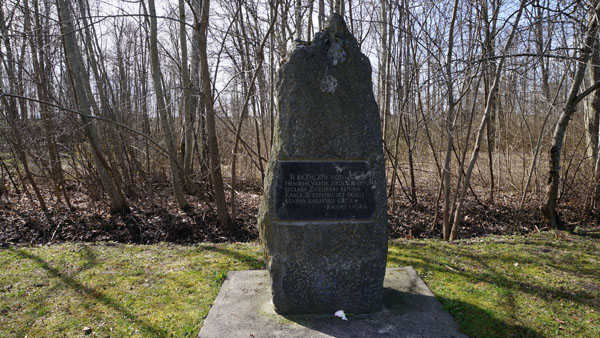

Salaspils battle memorial. ©Augustinas Žemaitis.
Vilnius Baroque churches/monasteries of Latgale
However Lithuanians had the largest direct influence in Eastern Latvia (Latgale) where Lithuanian monks successfully reintroduced Catholic faith in 16th-18th centuries after a brief Lutheran period. They have constructed churches of Vilnius Baroque style in local towns (the style is characterized by tall lean twin towers, developed in Vilnius). Some of the remaining ones: Berzgale (St. Ann church, 1770), Pasiene (Holy Cross church and Dominican monastery), Viļāni (Acchangel Michael, 1777, and Bernardine monastery).
Aglona, the prime pilgrim location of Latgale and whole Latvia has even more Lithuanian details. Its Vilnius Baroque styled Virgin Mary Assumption church is famous for a miraculous painting that has been created using the Virgin Mary painting at Trakai church as an example. Dominican monastery stands nearby. Moreover, Agluona is famous as the place where the first Lithuanian king Mindaugas was murdered in 1263 by Treniota. Therefore a statue for Mindaugas and his wife Morta has been erected there in 2015.


Aglona basilica, Vilnius baroque in style. ©Augustinas Žemaitis.
There is so much of Lituanity and Catholic faith (associated with Lithuanian rather than Latvian nation) in Latgale, and the local Latgalian language/dialect is so different from standard Latvian, that during the 1918-1922 territorial disputes an opinion existed that Latgalians are Lithuanians rather than Latvians and therefore Latgale should belong to Lithuania.
Kazakhstan
Kazakhstan was a nomadic land until the 20th century. The Russians annexed it in 1840-1860 and, after the communist revolution, forcibly settled the Kazakhs down into villages and towns.
They then used the emptied fierce local steppes (-40 C winter temperatures) for imprisonment, forced labor, and murder of political opponents and persecuted minorities from all over the Soviet Union.
Kazakhstan thus became a prison and a grave to many Lithuanians after the Soviet Union occupied Lithuania in 1940, with ~81 000 exiled to Kazakhstan (3% of the total Lithuanian population). Today, this part of the Soviet Genocide is reminded by the Lithuanian-funded monuments, museums. There is also the Lithuanian community who are descendants of GULAG (Soviet concentration camp) survivors that continues to create new Lithuanian sites in Kazakhstan.
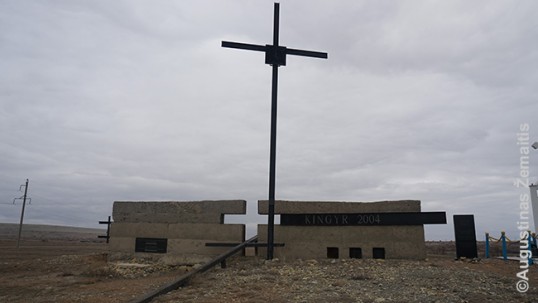

Kingyr Gulag Lithuanian memorial. A Vyšniūnas, M. Kurtinaitis, 2004.
Karaganda Karlag Lithuanian memorials
The largest GULAG system in Kazakhstan was based around Karaganda (pop. 500 000) and known as KARLAG. Its HQ was at Dolinka village, where Karlag museum now occupies that Stalinist building. Inside, there are somewhat-toned-down yet informative stories about the Gulag presented in an impressive way, with massive frescos and dioramas.


Karlag museum in Dolinka
There are also replicas of torture cells – however, in reality, the building has not been used for „bloody purposes“, instead of being the posh base of the Gulag‘s leadership. The leader‘s cabinet is authentic and there is even a fountain in the courtyard.
Karlag‘s prisoners were spread among numerous towns and villages, built by their own forced labor. On the whole, Karlag controlled areas larger than Lithuania itself.
In fact, the entire Karaganda city was built by the forced labor of the Karlag prisoners. These prisoners have also been forced to work in the nearby mines, which were especially dangerous and detrimental to health, leading to especially high death rates (30% per year and more). Even in 1954 (after Stalin died), this GULAG housed some 20500 prisoners, ~3000 of them Lithuanians (15% of the total, even though Lithuanians made up only 1% Soviet Union population). During the reign of Stalin, the prisoner population there surpassed 60 000 at a given time.
Among the most infamous and deadly Karlag "posts" was the Spassk GULAG 30 km southeast of Karaganda. It was once nicknamed "brotherly graves“ due to high death rates. The location where dead prisoners use to be buried without any gravestone has been now repurposed as memorial cemetery with numerous new gravestones. Every "gravestone" is for a nation rather than a single man. Azerbaijanis, Georgians, Latvians, Poles, Jews, Armenians, Estonians, Russians, Koreans, Germans, Romanians, Hungarians, Italians, Belarusians, Karachay/Balkars, Persians, Slovaks, Spanish, French, Ukrainians, Armenians, Chechens/Ingushetians, Kyrgyz, even Japanese, Koreans and Philipinos have their memorials. Some of these peoples ended up in the cemetery as prisoners of war (e.g. Germans, Italians, Romanians, Japanese) because they fought against the Soviet Union in World War 2. Others, however, were victims of genocide as their entire nations were deported into Kazakhstan based on the ethnicity alone (e.g. Chechens, Ingushetians), the majority of such deportees being children.


Lithuanian main memorial at Spassk. The inscription reads 'Lietuviams, kentėjusiems ir žuvusiems Karlage' (for the Lithuanians who suffered and died in Karlag), while the symbol used is the Cross of Vytis superimposed on prison bars. Sculptor J. Jagėla, architect A. Vyšniūnas.
While all the nationalities have just a single gravestone, there are Four Lithuanian memorials in Spassk. The main Lithuanian memorial is located next to all the other national memorials at the entrance of the cemetery (constructed in 2004).
Additional three Lithuanian memorials are located approximately at the center of the cemetery.


Three other Lithuanian memorials at Spassk
The 1990 Lithuanian memorial was constructed by the visiting relatives of GULAG prisoners while Kazakhstan was still part of the Soviet Union. In fact, that simple marble construction was the first memorial in Spassk, which was then followed by the other nations as well as the other Lithuanian groups which constructed their memorials. The third Lithuanian memorial (a small cross) has been erected in 2011 by an SUV club „Pajūris“ which selected Kazakhstan as the end-point of their journey, while the fourth Lithuanian memorial (a large artistically-carved cross) was erected in 2017 by the Karaganda Lithuanians.


1990 Lithuanian memorial in Spassk, built unofficially with whatever materials were then available
In 2020, Lithuanian exile graves were moved from Rudnyk (see below) to Spassk when the Rudnyk cemetery was condemned to become part of a mine.
Spassk GULAG may be reached from Karaganda by a rare bus 171 to Aktogai, it is possible to return by hitchhiking. Spassk is located en-route from Karaganda to Almaty.
Except for these memorials and the Dolinka museum, it is generally impossible to see much by visiting the former GULAG buildings in Karaganda or anywhere else in Kazakhstan. Some of them were abandoned and now lay in ruins (these may often be accessed, but little remains there). Others have been repurposed to general prisons or military bases (e.g. the one in Spassk), and remain inaccessible to the general population.
Karaganda Lithuanian life, museums, and church
To this day, Karaganda has the most visible Lithuanian community in the former places of Soviet exile. While most of the Karlag survivors managed to return to Lithuania in the 1950s after the new Soviet leader Nikita Khrushchev gradually dismantled the genocidal Stalin‘s policies, some have remained and their descendants now number ~2000 in the region and ~500 in the city itself.
While under the Soviet rule, the Lithuanian life centered around the St. Joseph Roman Catholic church (Kominterna st. 22, Maikuduk suburb). It has been built by a Lithuanian priest Albinas Dumbliauskas in 1977-1980 to become the sole Catholic church in the city (and, according to some sources, entire Central Asia). The building of a new Catholic church in the atheist Soviet Union was akin to a miracle. The story behind such miracle is that Dumbliauskas, unable to officially work as a priest or be jobless (according to the Soviet job laws), worked as an ambulance driver in Karaganda. While doing so, he helped a major Soviet official; in the Soviet Union, it was common to bribe doctors to perform their duties well, however, instead of a bribe, Dumbliauskas asked that the official would influence Moscow authorities to permit the construction of the church. A Lithuanian-language memorial plaque for Dumbliauskas and a multilingual (Lithuanian/Russian/German/Latin) memorial plaque commemorating the church‘s construction now adorn the church‘s side facade. Although having a strongly Lithuanian history and still cared for by a Lithuanian pastor (2018), the church itself was not Lithuanian but, as the area's sole Catholic church, was meant to serve all the Catholics exiled to Karaganda (that's why the inscriptions are also German and Russian).


Karaganda church, built by a Lithuanian priest


Karaganda church, built by a Lithuanian priest (interior)


Memorial plaque for the Lithuanian priest


Memorial plaque for church construction
After the independence of Kazakhstan, numerous new Lithuanian sites sprung up, often created by the leader of the local Lithuanian community Vitalijus Tvarionas (who is also a builder of many Lithuanian memorials in Kazakhstan).
In the northern suburbs of Karaganda, there is Lithuanian courtyard Lithuanian restaurant and art gallery (Litovskij dvor). Lithuanian national cuisine dishes (like great stuffed potatoe dumplings etc.) are served there.


Karaganda Lithuanian restaurant


Lithuanian restaurant in Karaganda
Next to it, there is a small Lithuanian house-museum (Litovskij dom-muzej) full of Lithuanian crafts. The exterior of both buildings is adorned with Lithuanian flags, traditional crosses and more. Both are open every day and are located at Taka Shabokina 4.


The interior of Karaganda Lithuanian home-museum
In the southern Karaganda, the Kazakhstani government has constructed the Palace of Friendship [Shakhterlar Avenue 64, 49.792015, 73.150051] to celebrate the multiethnic heritage of Karaganda. There, every major community of Karaganda has its own office, and so do the Lithuanians. There is also a Museum of ethnicities with a Lithuanian section (open every day). Each section is dedicated to an ethnicity that has its officially-registered community in Karaganda, most of such communities having roots in the Soviet exiles. Each section has various things dear to that ethnicity, as well as the folk costume.


Palace of Friendship in Karaganda


Lithuanian exhibit at the Palace of Friendship in Karaganda
In the main Karaganda regional museum [Bukhar-Zhyrai 47], a Karlag exhibit has been established too. However, there is nothing specifically about Lithuanians and there are better Gulag exhibits elsewhere.
Karaganda also has a street named after Lithuanians (Litovskij pereulok).
Zhezkazgan and the infamous Kengir GULAG
Zhezkazgan city was the site of the infamous Kingyr GULAG. There, a massive uprising against the Soviet regime took place in 1954, crushed by the Soviet authorities despite the spirit of de-Stalinization that prevailed then, after Stalin‘s death.
The buildings of the Kingyr GULAG now either lay in ruins, are abandoned, or have been replaced by factories. They are located near Zhastar St. [47.778274, 67.733655 – Osoblag HQ, 47.776377, 67.732917 – abandoned GULAG officials zone, 47.779212, 67.729462 – abandoned GULAG buildings]


The remains of the Gulag at Kingyr
However, in 2004, Lithuanians have constructed a massive Lithuanian Kingyr memorial at the presumed site of GULAG‘s cemetery of murdered, tortured-to-death or worked-to-death prisoners [47.775564, 67.756784]. The memorial was designed by architect A. Vyšniūnas (himself born in Kazakhstan to exiled parents) and it has incorporated the remains of a simpler earlier memorial: a tall cross erected by the first Lithuanian expedition to the places of exile in Kazakhstan in 1990 (that expedition was organized and done by the exiled Lithuanians themselves as they revisited the locations of their exile). The cross has been toppled by strong winds in the late 1990s or the early 2000s. The memorial was expanded in 2019 by adding additional cross and authentic slabs from the Kingyr gulag.
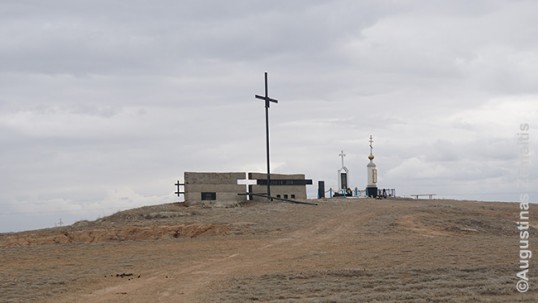

The memorials at Kingyr Gulag (Lithuanian is on the left)


The side of the Kingyr Lithuanian memorial
While it is unclear if the Lithuanian memorial truly stands at where the Kingyr GULAG cemetery used to be located, the massive memorial atop a hill that is visible from the nearby road and railway became a well-known hub for further memorials. The Lithuanian memorial thus has been since joined by smaller memorials dedicated to Latvians, Ukrainians, and Russians who perished in Kengir. All the memorials and the GULAG itself may be accessed from Zhezkazgan center by bus 96.
Kingyr was part of a larger GULAG system known as Steplag and, statistically, there were more ethnic Lithuanians incarcerated there than people of any other ethnicity, except for Ukrainians. All this despite Lithuanians making up just 1% of the Soviet Union‘s total population.
An even eerier Steplag location to visit was Rudnyk (marked on maps as an exclave of Zhezkazgan city west of the city of Satpaev, 26 km northeast of Zhezkazgan-proper). That town used to be the post of Steplag that housed the most prisoners and was especially deadly (in the years 1942-1943, for example, some 100 prisoners used to die every day, out of the total population of 9000-12 000; the dead prisoners were constantly replaced by new ones).
Currently, the Stalinist-era town is dying itself as it is to be replaced by an open-pit mine. Many of its buildings are abandoned or destroyed, and its central park also seems derelict. Behind the Rudnyk‘s central park lays the Rudnyk cemetery. While the original GULAG prisoner cemeteries did not survive (their locations being unknown), the Rudnyk cemetery also has numerous Lithuanian graves: there, people who died after being let out of the GULAG yet stayed in Kazakhstan (or died before managing to return to Lithuania) are buried. The cemetery is unique because Lithuanians there are buried in a single spot next to each other. Nine graves form a single Lithuanian memorial, adorned by a concrete cross. Note: in 2020, the memorial and remains were removed to Spask
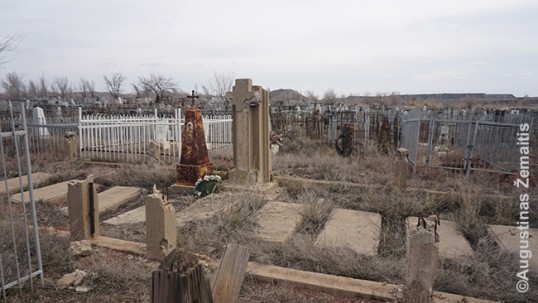

Rudnyk cemetery Lithuanian memorial
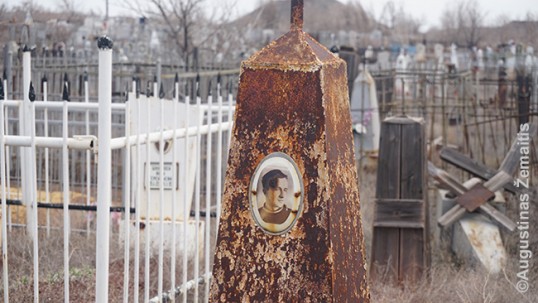

Close-up of the grave of Vytautas Albinas Miklaševičius, a lieutenant of the interwar Lithuanian army who came from a family of army officers. This is the best-surviving grave and the only one with a larger memorial. Several other graves are so damaged that it is even not known who is buried there as the inscriptions are illegible


Rudnyk city park entrance (cemetery is beyond the so-called park)
Possibly every larger Christian cemetery in the area of the former Gulags has some Lithuanian burials, as some Lithuanians were either unable or did not want to return to Lithuania, where the Soviets have destroyed the previous lives they had: natinalized all the property, possibly killed off the relatives and friends. Such Lithuanians eventually died in Kazakhstan and were buried in local cemeteries. Their graves are adorned by Catholic crosses (sometimes Lithuanian sun-crosses) and often also Latin-script epitaphs in Lithuanian. Many such graves look quite derelict, however, as all the relatives went back to Lithuania or died. A simple walk in any cemetery often leads to discovery of Lithuanian graves, but, except for Rudnyk, they are usually separate from each other.
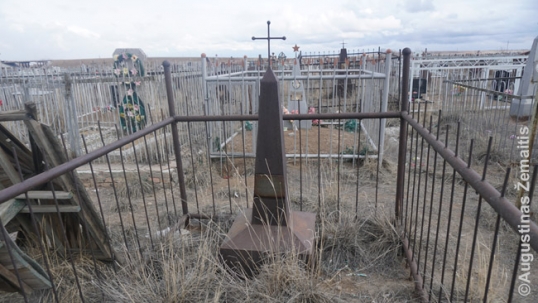

A grave of Lithuanian Pakarklytė in Zhezkazgan Christian cemetery, possibly with a destroyed chapel-post on left
Zhezkazgan regional museum has a section dedicated to Steplag with the information on these statistics and more (2nd floor). There, images of the Lithuanian memorials are also available.


Zhezkazgan museum interior
Balkhash GULAG and Lithuanian memorial
Yet another Lithuanian memorial for GULAG victims stands in Balkhash, not far from the Lake Balkhash. There, another GULAG was located (Peschenlag). The entire city of Balkhash has been constructed by forced labor.
The memorial has been constructed in 2004 and has „Lietuviams kentėjusiems ir žuvusiems Pesčianlage“ (For Lithuanians who suffered and were killed in Peschenlag) inscribed on it in Lithuanian and Kazakh languages. It has joined an earlier Japanese (1993) memorial and has been joined by a later Kazakh-funded multi-ethnic memorial.
The Balkhash GULAG itself is in ruins.
Astana and north Kazakhstan Lithuanian sites
Astana, the new capital of Kazakhstan (since 1997) is gleamingly post-Soviet. Therefore, it has very different kind of Lithuanian sites: those related to the rather cordial relationship between the two newly independent states.
Kazakhstan hosted the Expo 2017 world exposition, and its symbols – sculptures with eggs representing each country (including the Lithuanian ball) stands at Nurzhol Avenue near the Kaz Munay Gas HQ en-route to Bayterek.
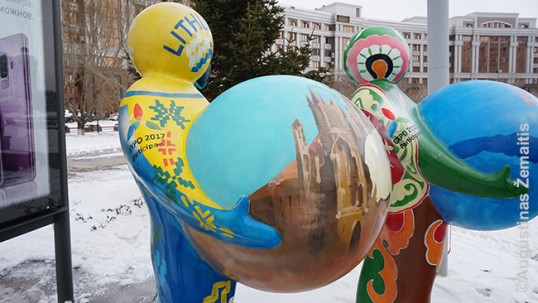

Expo 2017 Lithuanian ball in Astana
The Museum of the First President of Kazakhstan [11 Beibitshilik Street] puts a heavy emphasis on the gifts received by the president of Kazakhstan Nursultan Nazarbayev from various foreign countries. Many of these gifts are from Lithuania and the „Amber gifts“ exhibit is dominated by Lithuanian crafts.


One of numerous Lithuanian gifts to Nursultan Nazarbayev at the Museum of the First President of Kazakhstan
Near Astana too, however, the dark Soviet past is present. The nearby village of Akmol (still often known by its Soviet-era name Malinovka) houses ALZHIR museum, located in the place of the former GULAG where the wives of the incarcerated „enemies of the state“ used to be kept. As this GULAG was the most active in the 1930s (before the Soviet Union has occupied Lithuania), few Lithuanian women ended up there (14, according to the official statistics). Still, as the area became a potent memorial for the cruelty of the Stalinist regime (which even jailed innocent women for the sole reason of them being wives or sisters of the political prisoners), the Lithuanians have erected a Memorial for the Lithuanian women in ALZHIR, next to similar memorials built by the other nations. Akmol village may be accessed using the buses 300 and 312 from Astana (which leave the Azija Park shopping mall stop).


Lithuanian memorial at ALZHIR with museum behind it
In the Rudnyy city of northern Kazakhstan (pop. 100 000) there stands a Statue of Marytė Biežytė and there is a street named after her. She was a woman born in Lithuania who saved two local children by pushing them away from an approaching truck, dying herself why doing so. That story is famous in Rudnyy.
Diary of the Global True Lithuania expedition to Kazakhstan
|
While there have been many missions and expeditions to the places where Lithuanians were exiled, most of these expeditions concentrated just on visiting these sites of sorrow and paying respects to the victims by taking care of their graves. Such, for example, are the goals of „Misija Sibiras“, the most famous of such expeditions that take place annually and has visited Kazakhstan in 2009. A few other expeditions, especially ones led by architect A. Vyšniūnas, constructed their own memorials in Siberia and Kazakhstan. Neither of those expeditions would concentrate on marking down the exact sites of these locations, leaving little information for the tourists and those planning further expeditions alike, each of them having to discover everything on their own. For instance, when I contacted „Misija Sibiras“ regarding the sites of the graveyards of the expelled Lithuanians they helped to tidy, they, unfortunately, were unable to tell me that information as they claimed they don‘t keep it. In my own preparation to visit Kazakhstan I, therefore, was happy to learn that at least one recent expedition to Kazakhstan actually had a goal to find and mark the locations of all these places of Lithuanian sorrow as well as the Lithuanian memorials already commemorating that. I have met one of its participants PhD Linas Kvizikevičius whose information has been helpful in locating and photographing the sites for „Global True Lithuania“. On 2018 04 04, we have visited the ALZHIR GULAG. We have been surprised to learn that, although the GULAG even has a Lithuanian memorial, few Lithuanians have been incarcerated there (14, according to the museum). We have checked the wall with victims‘ names for Lithuanian surnames but have been largely unsuccessful, coming to believe that many names were Russified by adding Russian endings (at least two names looked Lithuanian, like Dargis, but were male rather than female). The museum workers directed us to a memorial for Stalinism victims but claimed that the GULAG‘s cemetery is inaccessible at that point of the year (March). On 2018 04 05, we have visited the Museum of the First President in Astana, checking what Lithuanians gifts are exhibited there. In the afternoon, we‘ve left Astana for Zhezkazgan in a night train. On 2018 04 06, after arriving in Zhezkazgan, we went to the bus station to check the possibilities to go to Rudnyk. There was no direct bus, but we went a bit closer to the Satpaev town (bus 101) and from there caught a taxi – a Soviet Zhiguli. The destruction and abandonment in Rudnyk have overwhelmed us, the entire town seemingly hanging between life and death. „Don‘t look at the schedule, the buses to Satpaev don‘t go that frequent anymore“ – old ladies at the bus stop told us as we checked when could we go back by bus. Having walked through the entire town we reached its end, where, even with coordinates of the cemetery known to us, we did not understand which dirt road to walk to continue. We have asked people who worked at a lonely building on the way and they showed us the wrong path where we were able to get close to the cemetery but an irrigation ditch separated us from it. There, an illegal archeologist was searching for something with a metal detector. Eventually, we got around the ditch and went to the cemetery, canvassing it for the memorial. Back in Zhezkazgan (by two buses, the Rudnyk-Satpaev one being unexpectedly crammed), we stayed in a local sanitarium-turned-hotel and walked around this prisoner-built city, seeing its numerous Soviet memorials and murals (Lenin has been toppled to be replaced by Ketbuka, however). On 2018 04 07, we made a long 7 km walk from central Zhezkazgan to the former Kingyr lager. On the way, we passed seemingly-crumbling Soviet industry and the related pollution. We have been unable to thoroughly investigate the lager itself, as the abandoned buildings had large dogs around them. We, however, went to the Lithuanian memorial, becoming inspired by its large size and it being visible from rather far away. It started raining, but the way back always used to be easier than the way forward, as in such remote locations any available bus usually goes back to the city center (whereas at the center, it is usually hard to know which bus (if any) goes to that remote destination, as places like Zhezkazgan have no route maps or schedules either online or at the bus stops). Indeed, the only bus that comes each hour to a nearby stop brought us back. There, in the center, we have visited the local history museum, spending the most time at the GULAG exhibit. We were suggested to also visit its another site dedicated to cosmonauts but few locals could help us to find such a building. Eventually, we went to the train station and, as we still had time before the train, we visited the Zhezkazgan cemetery, knowing that many of the Lithuanian imprisoned in the GULAG there weren‘t immediately allowed to return after their exoneration and had to stay in Zhezkazgan, so they were likely buried there. In a non-exhaustive search, we discovered one such grave, belonging to Pakarklytė, before a massive rain hit. Late in the evening, we departed in a night train to Karaganda. On 2018 04 08, we have arrived at Karaganda, visiting the local museum and finding the Gulag exhibit there sub-standard, mostly concentrating on portraits of Kazakhs who were imprisoned there. We also planned the next couple of days, researching the bus routes needed as well as their schedules. On 2018 04 09, we have left the rented apartment early in the morning so we could leave on 8:30 bus, which proved to be one of only two buses that day stopping by the Spassk memorial, some 30 km southeast. It was a bus going to Aktogay, some 300 km away, therefore, the tickets to the first stop were sold just when less than 30 minutes were left to the bus departing as the bus station still expected that more passengers who would ride further would come up. An even bigger surprise came in Spassk as we exited the bus – we were seemingly left in the middle of the nowhere, except for the strong winds and coming rain clouds, as our bus went on using the lonely road in the inhospitable Kazakh steppe. After taking the images of the memorial, we understood we‘d have to hitchhike back, but in Kazakhstan, a Soviet-era Niva SUV stopped even before we raised our hands. That‘s because hitchhiking is paid in Kazakhstan, and many drivers hope to earn an addition to their wages this way. The driver insisted on leaving us at Yugo-Vostok closed bus station instead of the city center, and from there we called Vitalijus Tvarionas, whom we knew to have been an especially active leader of the local Lithuanian community and a creator of many Lithuanian sites in Karaganda. Even before learning of our goals, he invited us to the Lithuanian Honorary Consulate (where he is the consul) and offered to drive us around. He showed us the sites he created and owns (Lithuanian House-Museum, Lithuanian restaurant), the Lithuanian-built church we didn‘t know about, a new cathedral, the Palace of Friendship where, unfortunately, the museum was closed. Tvarionas also told us much about the life and activities of the Karaganda Lithuanian community. On 2018 04 10, we spent the morning visiting the yesterday-closed museum at the Palace of Friendship, learning about the Karaganda‘s all communities. Later on, after checking out from the flat and taking our bags, we went to the bus station and then to Dolinka. After additional 2 km walk, we reached the museum there and were pleasantly surprised by its scale and informativeness, as well as modernity. We didn‘t find any Lithuanian memorials in front of it, but Tvarionas told us yesterday he is creating a cross that will be erected in Dolinka in the summer of 2018. Later in Almaty, we have met a Lithuanian priest Juris who serves in the church of Karagandy built by Dumbliauskas. At the time, he was in the convention of Kazakhstan's priests in Almaty. He told us the story of the church. We have also met the general consul of Lithuania in Almaty Darius Vitkauskas, who expressed the interest in our work, hopes that it would help him to learn more about the Lithuanian sites in Kazakhstan. He also explained his plans to offer basic Lithuanian culture courses in the consulate in hopes that they would attract the descendants of exiled Lithuanians who have lost the connection to Lithuanian culture. Moreover, we have also met Lithuanian expatriates businessmen living and working in Almaty, of which, we have learned, there are over 100 and possibly up to 1000 all over Kazakhstan, as Lithuanians used well the Kazakh policies encouraging attraction of foreign experiences; coming from a rather economically-advanced country, Lithuanian businessmen have many experiences to use, yet, being from the former Soviet Union, they are also well-versed in the post-Soviet nuances and Russian language. This group of Lithuanian expatriates has not created any visibly Lithuanian sites so far, however, but the Lithuanian-owned companies are prominent in certain fields of Kazakh economy. Augustinas Žemaitis, 2018 04-10. |


Augustinas Žemaitis met Linas Kvizikevičius before the visit to Kazakhstan
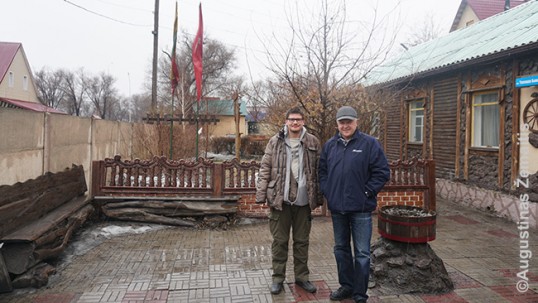

Augustinas Žemaitis and Vitalijus Tvarionas in Karanagda near the Lithuanian house-museum


Augustinas Žemaitis and Aistė Žemaitienė of Global True Lithuania in the General consulate of Lithuania in Almaty with Consul general Darius Vitkauskas
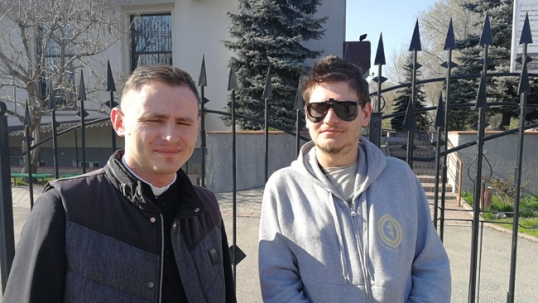

Augustinas Žemaitis with the Lithuanian priest in Almaty
Hungary
Since 2013 Budapest has a statue of the Lithuanian king of Poland and Grand Duke of Lithuania Jogaila and his Hungarian wife Hedwig of Anjou. The husband and wife sits quite apart from each other, this symbolising the age barrier that separated them. The space in-between is filled with coat of arms of Lithuania, Poland and Hungary; the monument also has the Columns of Gediminas symbol. The stature has been unveiled for the Lithaunain presidency of the European Union Council and represents a popular thought that the peacefully united Polish-Lithuanian Commonwealth was a kind of predecessor to the European Union. Moreover by adopting a Western (Catholic rather than Orthodox) form of Christianity Jogaila also set a pro-Western political momentum for Lithuania, which continues to this day. The sculpture is located near European park where every European capital had planted a tree. It had been funded by the Lithuanian government and created by Lithuanains: Dalia Matulaitė, architects Jūras Balkevičius, Rimantas Buivydas.
Despite of this however the Latin plaque on the sculpture calls the King by his Polish name Jagiello. Not only that he is called "Wladislaus Jagiello, Rex Poloniae Et Dux Supremus Lithuaniae 1386-1434" (Wladislaus Jagiello, King of Poland and Grand Duke of Lithuania 1386-1434", but he is also anachronistically called "Jagiello, Magnus Dux Lithuaniae 1377-1386" (Jagiello, Grand Duke of Lithuania 1377-1386) - even though in those days Lithuania had been his one and only realm and he was known by his Lithuanian name. Being an ethnic Lithuanian who accended to the Polish throne in his 40s Jogaila is known to have spoken Polish badly.
Since 2021, a commemorative plaque for Paulius Normantas exists in Nyíregyháza. Paulius Normantas (1948-2017) was a Lithuanian traveler, poet, and photographer who married a Hungarian woman and moved into Hungary in 1983, spending his life between his travels through Asia in Nyíregyháza. He traveled and photographed foreign cultures at the time when (due to the travel bans during Soviet occupation of Lithuania and the Soviet-ravaged Lithuanian economy) it was still rare for Lithuanians to travel, thus Normantas's works were some of the first glimpses into some remote eastern cultures from Lithuania. The plaque is located on Vaci Mihaly cultural center.
Tajikistan
Tajikistan is a historic part of the Persian nation that had been conquered by Russia and then ruled by Soviet Union.
Soviet Union used this far-away land to expell Lithuanians to. Some 1000 Lithuanians and ethnic German citizens of Lithuania were forcibly relocated there in 1945 to work in cotton plantations; they had to live in windowless shacks made of straw and forced to suffer malnutrition. Some 300 died the first winter and merely 300 were still alive by the time Stalin died and persecutions subsided (giving a 30% survival rate).
Qurghonteppa town (once known in Russian as Kurgan-Tyube) was the center of Lithuanian expulsions. It's cemetery still has many Lithuanian bodies, although the graves are crumbling. The members of Lithuanian youth initiative "Mission: Siberia" (that came to take care of Lithuanian graves there in 2011) constructed a small monument for the expelled Lithuanians. Architect Algis Vyšniūnas had prepared a project for a much bigger monument, but the local stone could have been used only for a much smaller and simpler one that reminds of a memorial plaque. Word "Lietuviams" ("For Lithuanians") is written on it.


Participants of Mission Siberia 2011 stand near the small monument they have built at Qurghonteppa Lithuanian cemetery. Photo by Mission Siberia.
An earlier Lithuanian expedition (1991) by exile survivors erected a cross in Qurghonteppa with Lithuanian and Tajik inscriptions "For the Lithuanian exiled people, who suffered and died in Tajikistan while being innocent in years 1945-1946" (author: D. Gediminskas). The website of Lithuania's embassy in Kazakhstan informs that the cross has been since destroyed "due to Afghanistan war" (Afghanistan is merely 50 km away).
Lithuanian expellees also lived in the surrounding towns and villages of Vakhsh, Uyali, Kuybyshevsk, but little remains there as the cemeteries have been largely destroyed. The exile in Uyali has been especially fierce - out of 50 people merely 9 survived the first two years.
While nominally only the ethnic German minority of Lithuania was targetted for expulsions to Tajikistan, the pretexts of such persecution included "being a teacher of German language", "having a relative living in Germany", "married to a German", "being Lutheran" or "having a German-sounding surname" - therefore, many Lithuanians were expelled as well.
During the later Soviet era when the genocide subsided, Tajikistan became popular for Lithuanian mountaineers as it had some of the Soviet Union's highest mountains (non-Soviet mountains were inaccessible to most Lithuanians at the time as Soviet Union did not permit them to leave the Soviet Union). After doing the first accents they would often give Lithuania-realted names to the peaks. Thus there is Lithuanian peak (6080 m), Donelaitis peak (5837 m, named after the first person who wrote fiction in Lithuania), Čiurlionis peak (5794 m, named after the Lithuania's best known painter). There are many other Lithuanian-named peaks in Pamir. However, it should be noted that while these names are well known in the Lithuanian mountaineering community, actually they are typically not listed on any maps or non-Lithuanian online sources about Tajikistan.
Lublin, Poland
Lithuania and Poland spent multiple centuries as a single country of Poland-Lithuania, and that united country began in Lublin, where the Union of Lublin was signed in 1569.
Much of the Old Town dates to that era and was seen by the signatories of the Union. While the Castle of Lublin has been rebuilt since then, its most famous part – the Holy Trinity chapel remains intact, and even includes a graffiti by a Lithuanian noble who came to sign the union in 1569.


Lublin Holy Trinity chapel


Grafitti on the Union of Lublin inside the chapel
The chapel is especially famous for its Medieval gothic murals that cover its every wall and vault. The chapel and the murals were funded by Lithuanian king Jogaila (known in Poland as Jagiello), who also became a Polish king in the 14th century. Therefore, among the murals of saints, you may also see a major mural of Jogaila kneeling before Virgin Mary with the Baby Jesus (left of entrance), a fresco of Jogaila riding a horse (on the left of the arch between nave and presbytery). On the vault above the altar place, there is the Cross of Jogaila, the symbol that still adorns the Lithuanian coat of arms.
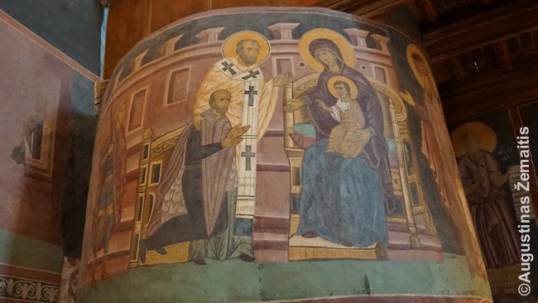

Kneeling Jogaila in a chapel fresco
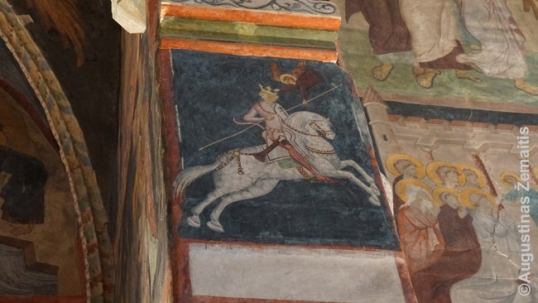

Jogaila ridinga horse on a fresco
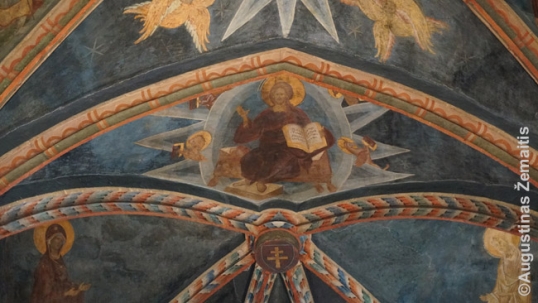

Ceiling adorned with the Cross of Vytis (Cross of Jogaila)
The Lithuanians who came to sign the Union spent their days in what is now known as the Lithuanian Square (Litewski). In that square, a stone obelisk for the union was commissioned soon after signing it. The authentic obelisk has been since destroyed by the Russians who occupied the city in the 19th century. However, a new metal obelisk for the Union of Lublin has been constructed in its place.
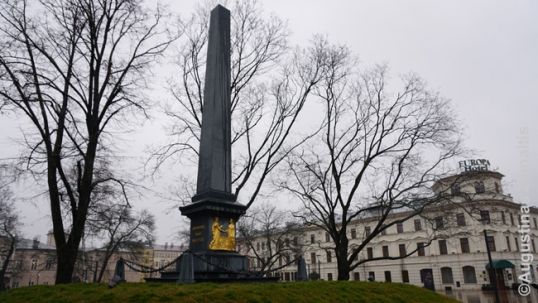

Union of Lublin obelisk at the place where the Lithuanian delegation stayed at the time
The Union of Lublin is controversial in Lithuania itself and often considered an act of treason done by its signatories. That‘s because according to the Union Lithuanian ceded some half of its territory to Poland and Polish was de facto definitively established as the dominant culture and language of the new country. In Poland, however, the Union is held in a much more positive light, and an explanation plaque near its monument describes the union as a democratic multicultural merging of the nations.
The later history of Polish-Lithuanian relations have been even more controversial and its evaluations even more different in the two countries.
Two more memorials in the Sq. Litewski of Lublin reminds two more things that are considered glorious in Poland but held to be despicable in Lithuania. The first one of them is the May 3rd constitution which (according to most interpretations) has effectively disestablished the Lithuanian part of Poland-Lithuania by merging both countries into a single country known as Poland. The second, even more controversial, is the Polish president Józef Piłsudski. While he considered himself a Lithuanian, Lithuanians see him as a traitor as he disagreed with the notion of independent Lithuania (1918) and, as Polish president, masterminded the annexation of Lithuania‘s capital Vilnius to Poland as a part of his plan to recreate the old Polish-culture-dominated Polish-Lithuanian Commonwealth that began in Lublin, 1569.
Bulgaria
Bulgaria has a multitude of sites related to Jonas Basanavičius, a person who is known in Lithuania as the patriarch of Lithuania. Basanavičius was instrumental in creating the first Republic of Lithuania (declared in 1918). He was a Lithuanian born in Lithuania but spent 25 years in Bulgaria where he also started his political career. In Bulgaria, he worked as a doctor in the cities of Varna and Lom.
While his fame in Bulgaria was not nearly as big as in Lithuania, he still became quite famous, especially so in Varna where he served as a city councillor, suggesting turning Varna into a resort as well as establishing a Museum of Archeology (now the most famous such museum in Bulgaria).
Both Varna and Lom now have streets named after Basanavičius - however, the name is Ivan Basanovich rather than Jonas Basanavičius. Back in those days it was common to use different versions of one's name depending on the language, and Ivan Basanovich is a bulgarianized version of Basanavičius's name which he used when speaking in Bulgarian to Bulgarians.
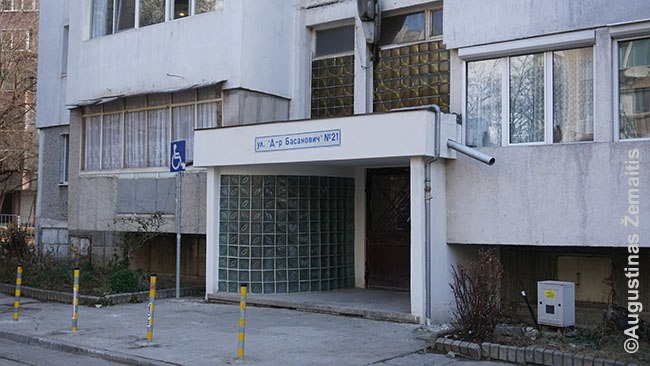

A socialist-era multistorey apartment block in the Ivan Basanovich street at Varna
Additionally, Varna has a small commemorative column dedicated to Basanvičius in Panagyurishte street. It is located on the spot where Basavičius's home (now destroyed) used to stand. On the pole Basanavičius's Lithuanian name is written, although in Cyrillic.
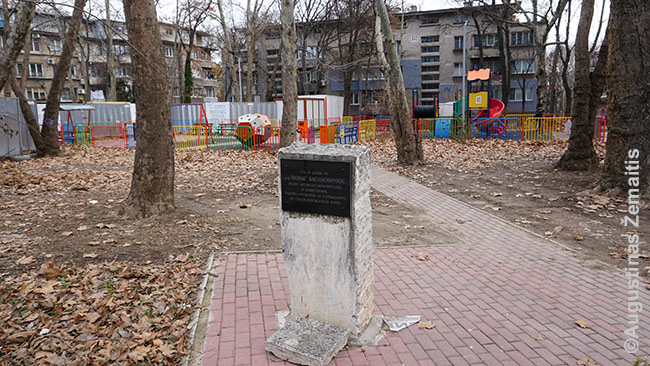

Memorial post for Jonas Basanavičius at Panagyurishte street in Varna
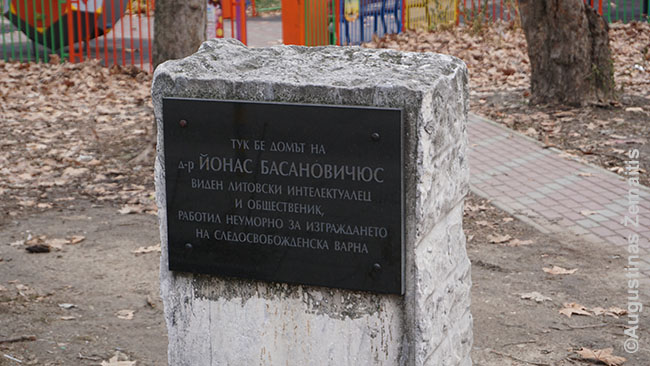

Memorial post for Jonas Basanavičius at Panagyurishte street in Varna
The newest commemoration of Jonas Basanavičius is a commemorative plaque dedicated to Basanavičius in Mirskiy street of Varna. It is located on house no. 3, another house where Basanavičius lived at. The plaque was installed by the embassy of Lithuania to Romania (and Bulgaria) in 2018, commemorating centenary of Lithuanian independence. The additional location where Basanavičius lived has been discovered by Mociškis, a prosecutor of Lithuania who travelled in Varna as a hobby.
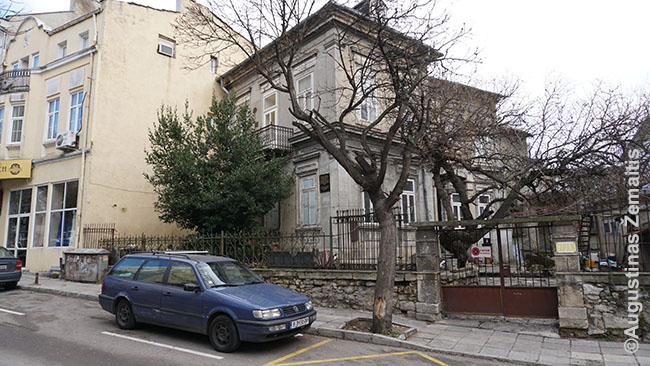

House where Jonas Basanavičius lived at Mirskiy street
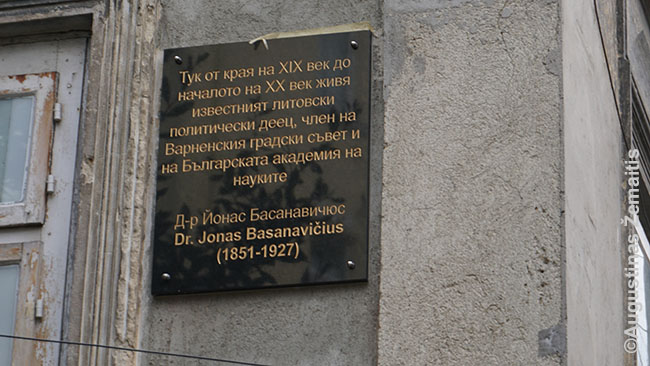

Commemorative plaque for Jonas Basanavičius at Mirskiy street
"Gabalėliai Lietuvos" TV laida apie lietuvių paveldą Bulgarijoje
Siberia (Russia)
Siberia is among the most dreadful words to a Lithuanian. Over 300 000 Lithuanian people have been expelled to Siberia by the Soviet occupational regime as a part of the Soviet Genocide there (1940-1953). Many were either then killed or worked to death in forced labor camps, or succumbed to the harsh climate and conditions. This was a taboo topic while the Soviet Union still existed: many of the exiled people were buried in the mass graves while the rest had only modest wooden crosses built for them. However, as Lithuania restored its independence, many Lithuanians built (or tried to built) memorials there.
Siberia, which is larger than entire Europe in area, is extremely cold (temperatures drop to -70 C in winter). Villages and towns here are surrounded by hundreds or thousands of kilometers of uninhabited grounds: this rendered escapes impossible and was the reason why these lands were chosen to expel those Soviets saw as their enemies. The largest expulsions of Lithuanians took place in 1941 and soon after 1944, using cattle carriages. In a single week of June 1941, 2% of the entire Lithuanian population was rounded up and forcibly expelled. Some were expelled to forced labor camps while others to simple villages. Women and children were expelled as well and, in total, more than 50% of victims were either women or children. Many (in some places the majority) died or were killed. Far-flung Siberian villages thus were peppered with meager Lithuanian graves and cemeteries, modest little crosses. After the death of Stalin, in 1953, most of the expellees who were still alive at the time were permitted to leave Siberia, making the graves of their dead relatives and friends no longer cared for. After the 1990 independence of Lithuania, many Lithuanians have tried to find these graves and bring the remains of their relatives to Lithuania; some of the remaining graves were cared for by Lithuanian projects such as "Mission: Siberia". The sites of many burials will never be known: many people (especially babies) died en-route to Siberia and were buried near the local train stations; other graves have completely crumbled; yet other exiles were buried by the regime in unmarked mass graves.


Lithuanian graves in Siberia. Image by Mission: Siberia project.
While technically Siberia is sometimes considered to be only a part of Russian Asia, in the Lithuanian minds, "Siberia" is the entire "Cold part of Russia where people were expelled to", thus it includes what is elsewhere known as "Russian Far East" or "Russian North".
The scale of genocide in Siberia far outflanked its Lithuanian victims. Many ethnic groups were expelled in their entirety, often losing their language and more than 50% members in the process. Despite being the place of one of the largest mass persecutions and killing campaigns in history, Siberia lacks any massive official memorials to its victims. As the current Russian government sees Russia as the continuing state of the Soviet Union, it seeks to gloss over the scariest parts of Soviet/Russian history.
Still, during the time Russia flirted with democracy ~1989-1992, the former deportees (and their descendants) themselves have built or commissioned numerous monuments in the following places:
*Vorkuta, Komi Republic - next to the sole surviving 26th mine cemetery near Yur Shor settlement.
*Abez, Komi Republic - next to prisoner cemetery, where the graves are marked by simple posts, Lithuanians built a monument "Flaming cross" with an inscription "To those who did not return". Lev Karsavin is also buried in this cemetery. He was an ethnic Russian who was forced to flee the Russian Revolution in 1922 and settled down in Lithuania, only to be captured by the Soviet Union together with the entire Lithuania, deported to Abez where he died.
*Inta, Komi Republic - crumbling cemetery received a monument with Rūpintojėlis (a traditional Lithuanian image of sad Jesus). Lithuanian graves are marked by crosses, one of them is marked by columns of Gediminas. Nearby is a memorial to Latvians who were also persecuted here. Interestingly, it was constructed in secret in 1956 while Latvia and Lithuania were still under deep Soviet occupation. It was likely saved by a neutral inscription "To the land of birth".
*Ezhva, Komi Republic - a metal cross was built. Its concrete postament has an inscription: "To those exiled in 1941".
*Ust Lekchim, Komi Republic - a modest memorial that resembles a gravestone has been built.
*Igarka, Krasnoyarsk Krai - a commemorative plaque has been unveiled at the regional museum.
*Norilsk, Krasnoyarsk Krai - three crosses (one Lithuanian, one Latvian, one Estonian) have been erected together with a triangular pyramid. This memorial reminds Lithuanian, Latvian, and Estonian soldiers who were expelled here in 1941 (45% have died even before their court dates due to persecutions). The monument is called "Golgotha of Norilsk" and is located at 69.321478, 88.165383. The soldiers have also been imprisoned north of Norilsk near lake Lama, where a 9 m height chapel-post was erected (sculptor Algimantas Sakalauskas, approximate coordinates 69.49373799, 90.68503785).
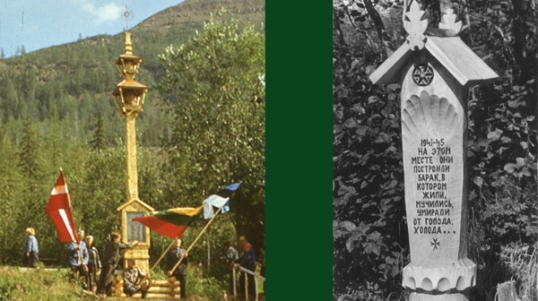

Memorials for Lithuanians near lake Lama near Norilsk. Photos by Algimantas Sakalauskas.
*Reshoty, Krasnoyarsk Krai - here Lithuanian intellectuals were imprisoned after separating them from their families. This
*Biysk, Altai Krai - a small red obelisk with Columns of Gediminas symbol on it was built.
*Lithuanians exiled to Altai Krai, mainly women, in many cases were exiled the second time to Yakutia (Lena River Delta). Such "repeated exiles" were common when Lithuanians were already "too comfortable" in the first place of exile, according to the regime. Monuments for Lithuanians were thus also built at Tit Ary settlement, Trofimovsk island.
*Chelyan, Buryatia Republic - in Chelyan cemetery a large cross for all the Lithuanians was erected in 1956 by the exiles who had been finally permitted to leave the place. The inscription poem reads "We are from the land of amber / a respectful homeland Lithuania / without script, who would be able to read the hardships / suffered by its heroes".
*Kolyma, Magadan Oblast - this Soviet concentration camp was infamous for its cruelty even by Russian standards. Thus, in 1995, Russians themselves built a memorial "Mask of sadness" here. Next to it, Lithuanians put a stone formed as a Cross of Vytis.
It is impossible to know if all the aforementioned memorials still stand. The Russian government does not look after them and the local Russians sometimes destroy them. "Mission: Siberia" expeditions to take care of the exiled Lithuanians' graves and monuments are no longer permitted; some cities are in the areas of Russia where no foreigners are allowed. For example, in 1990-1991 the returning exiles have built identical ~5 m tall Lithuanian crosses in all the places of Altay Kray where Lithuanians were expelled at. However, when checked ~2003, only a single one of those crosses was surviving and even that one had its commemorative plaque removed.
After Vladimir Putin came to power in Russia (1999), Russia essentially banned building monuments for exiled Lithuanians. In 2005, Lithuania had agreed with Yakutsk municipality to construct a memorial for Lithuanian exiles in Yakutsk that was paid for by Lithuania. However, the central government of Russia banned it and the monument thus had to be built in Vilnius instead (Aukų g.). As such, much of the 21st-century commemorative effort for the exiles has been concentrated on Kazakhstan, where some 20% of the total exiles were expelled and which is now independent of Russia.
By the way, some Soviet officials talked about expelling all the Lithuanians from Lithuania (Mikhail Suslov: "There will be Lithuania but without the Lithuanians"). This was what happened to Crimean Tatars, Chechens, Inguishetians, Kalmyks, and numerous other ethnicities. If this would have happened, this website would not exist: those ethnic groups that were expelled en-masse typically lost their culture and often the language. They also lost more than half of their population by the time they were allowed to return.
In the 1970s and later some Lithuanians participated in the settling of Siberia on their own free will (i.e. for a salary) as well. For example, Kogalym (a 50000-strong oil town in Khanty-Mansi Autonomous Okrug) was constructed by Lithuanian, Latvian, and Estonian workers ~1980. That's why it now has Vilnius, Baltic, Tallinn streets, a cinema "Jantar" (Amber), and hosts houses built in the Alytus house plant. As the Soviet government was building a new railway across Siberia called Baikal-Amur Mainline, each of the Soviet-ruled republics had to build a station there. In 1976, Lithuania built a station at Novy Uoyan (pop. 4000), Buryatia.
By the way, the expulsions of Lithuanians (and other prisoners or persecuted peoples) to Siberia did not start in the 20th century. In the 19th century, when Lithuania was ruled by the Russian Empire, Siberia as well as the Volga area was the destination for expelling those who participated in the revolts against Russia. They would be expelled on foot rather than in trains. The place where most survived from this time is located not in Siberia but in the Volga area, Chernaya Padina village and around. When Lithuanians were expelled here in the mid-19th century, it was still an uninhabited steppe. In that particular area, Lithuanians formed the majority of the population, thus allowing their language and culture to survive for well over a century. One nearby village was even called Litovka and the local pond (dug by Lithuanians) is still referred to by locals as the Lithuanian pond. Lithuanians also had a church there but it was demolished by the Soviets. A new chapel was built in 2004, founded by J. Kazickas - a Chernaya-Padina-born Lithuanian-American businessman. There are Lithuanian inscriptions about the area's history on the chapel and elsewhere. While the Lithuanian Catholic religious life was repressed by the Soviets and many Lithuanians left the area for good and repatriated to Lithuania quickly after the ~1920 Russian Revolution, all in all, here the Lithuanian culture was not destroyed because the forefathers of Chernaya Padina Lithuanians fought against Czarist Russia rather than Soviet Russia. During the Soviet times, they were thus able to say that they are descendants of "revolutionaries" (akin to communists) rather than descendants of "anti-Russian guerillas".
These days, Lithuanian communities exist in Irkutsk, Novosibirsk, Altay Region, and around Murmansk.
Kyrgyzstan
Kyrgyzstan had some of the highest mountains of the Soviet Union. At the time Lithuania was occupied by the Soviet Union, Lithuanian mountaineers found it nearly impossible to be allowed to travel outside the Soviet Union and climb the world-famous mountains there. So, instead, they often focused on the Kyrgysztan mountains. The well-known local Pamir range remains a favorite of Lithuanian mountaineers to this day. Under a tradition, Lithuanian mountaineers would name a summit if they are the first ones to accend it. Therefore, numerous so-called "Lithuanian summits" appeared: Vilnius University, Mažvydas (the author of the first Lithuanian book), Nemunas (the longest Lithuanian river), Žalgiris (a Lithuanian-Teutonic medieval battle), Lithuania millennium jubilee, Dotnuva. However, while these names are known in Lithuania itself, "Global True Lithuania" has been unable to find any non-Lithuanian map that would list them (if you have such a map, please share). Possibly, the names do not exist officially but only in the collective memory of the Lithuanian mountaineers.

